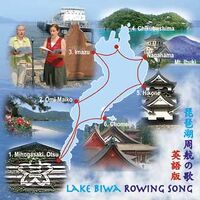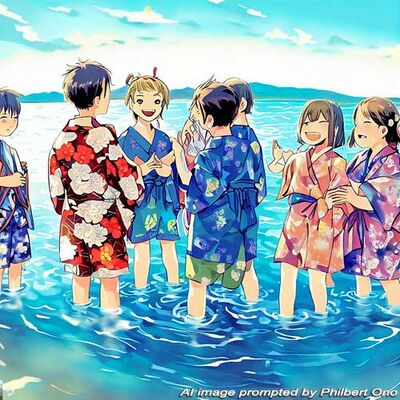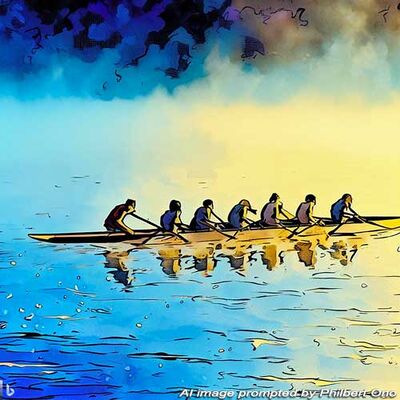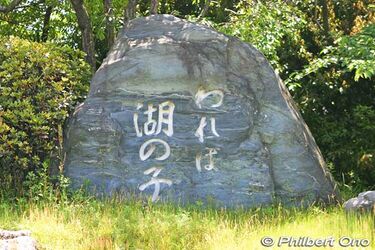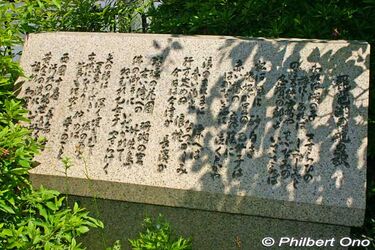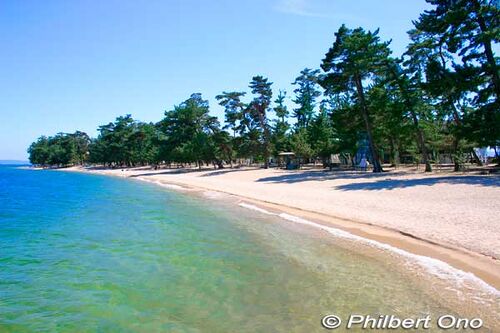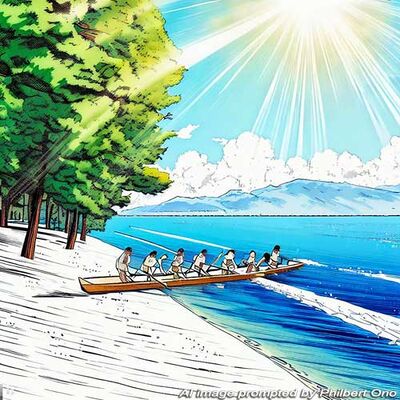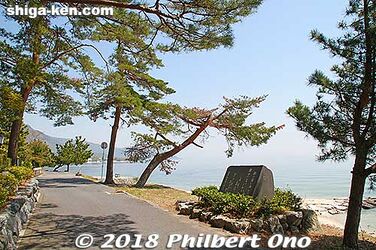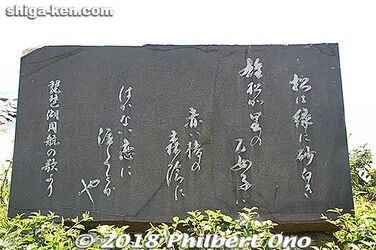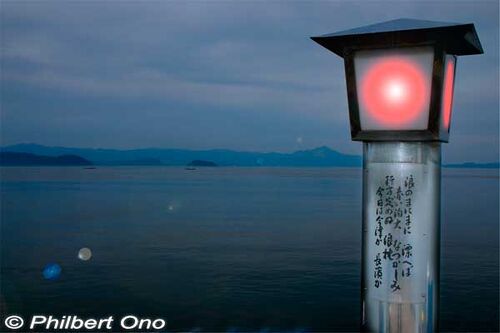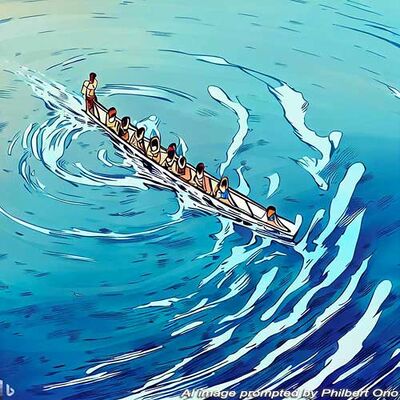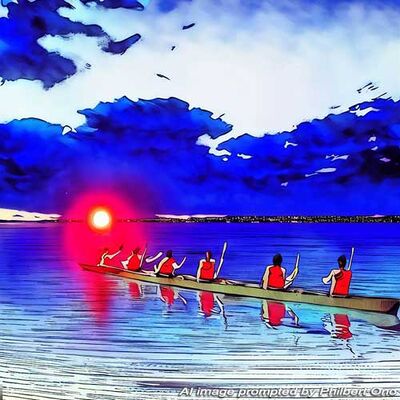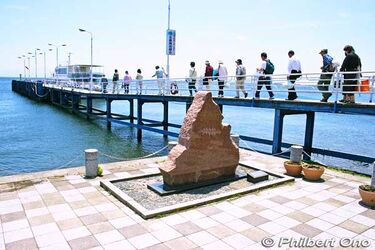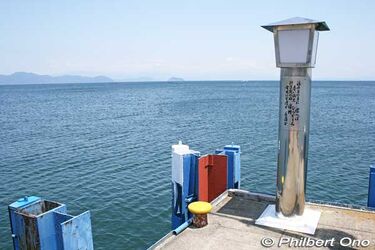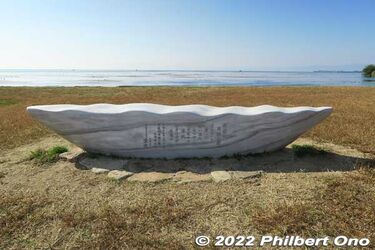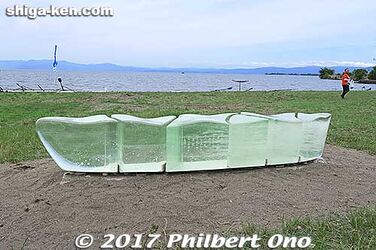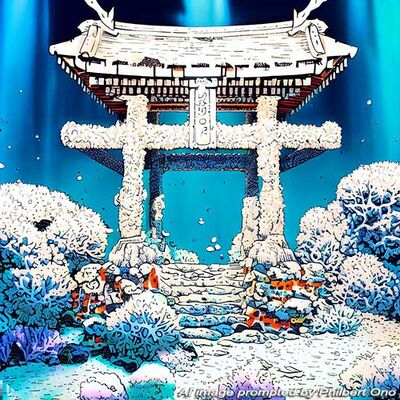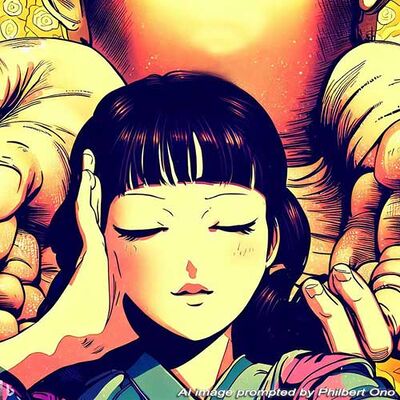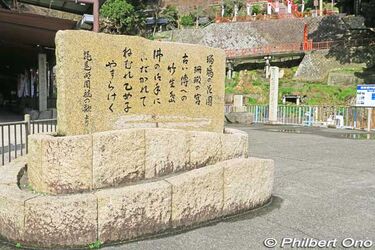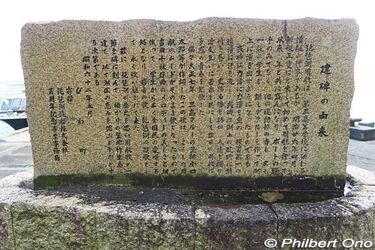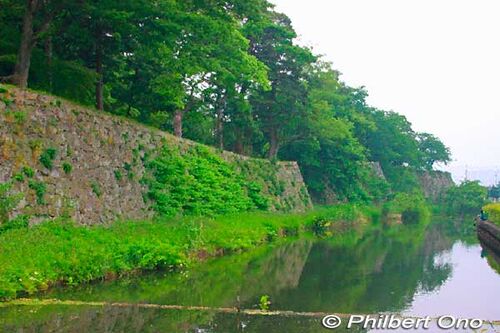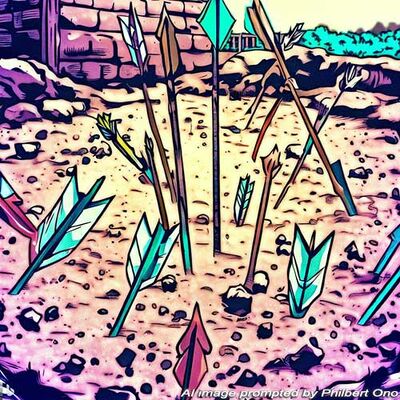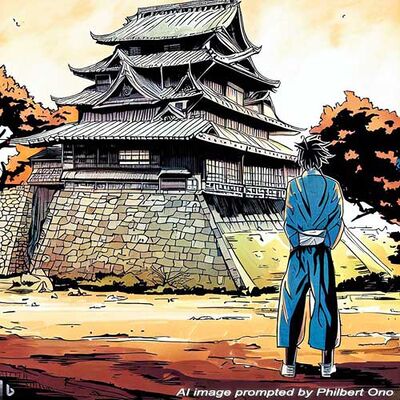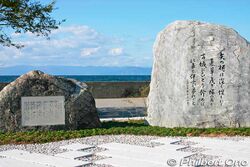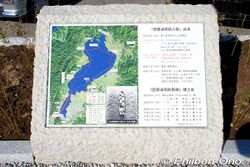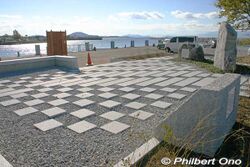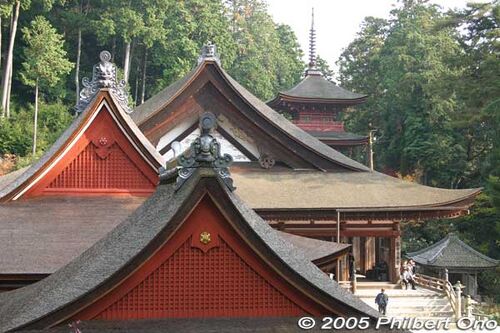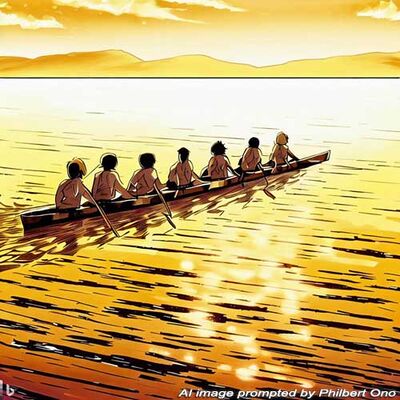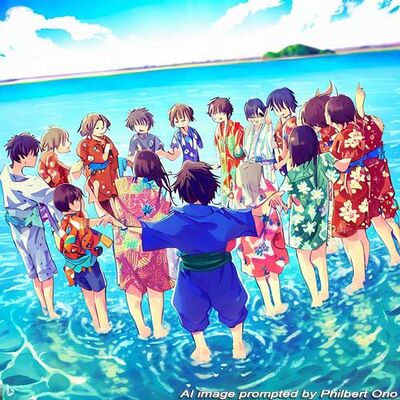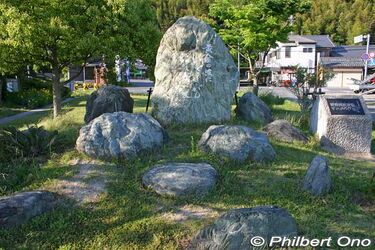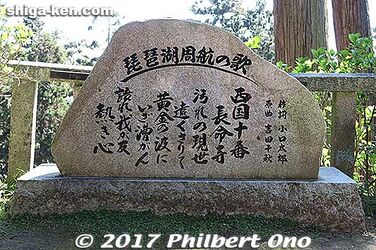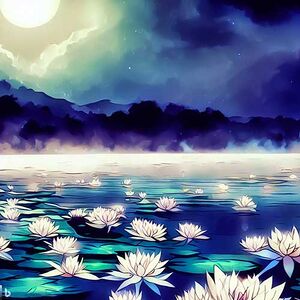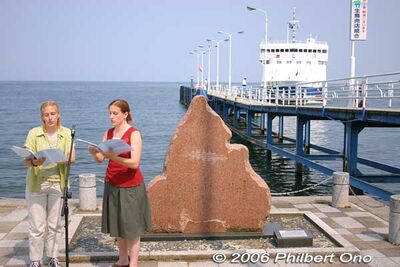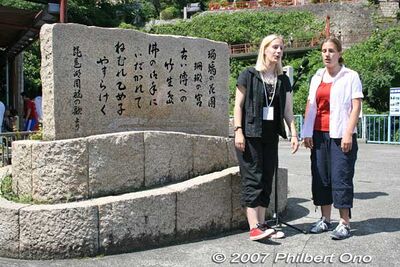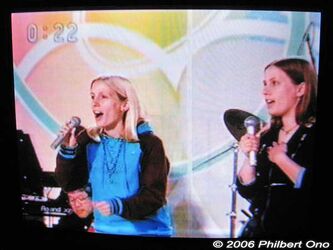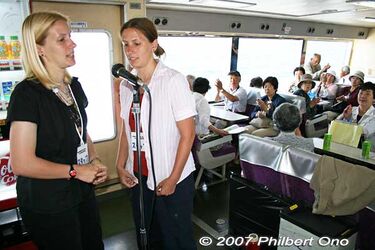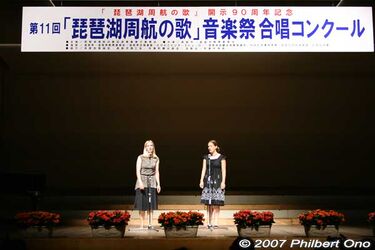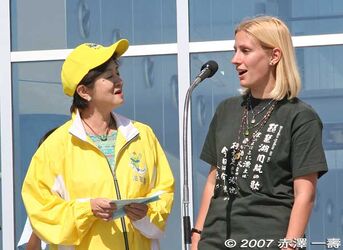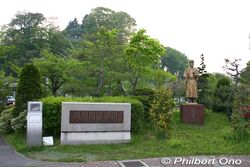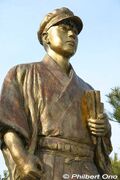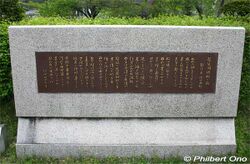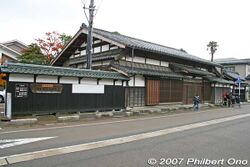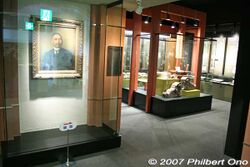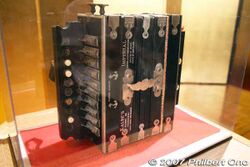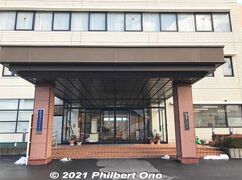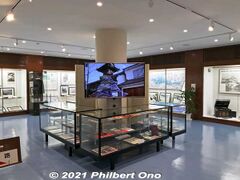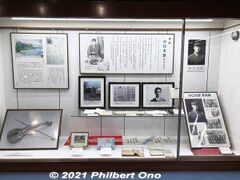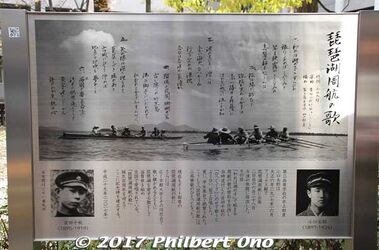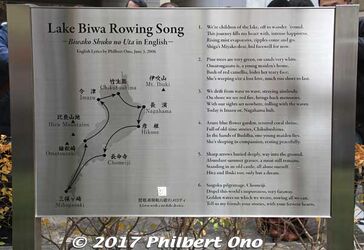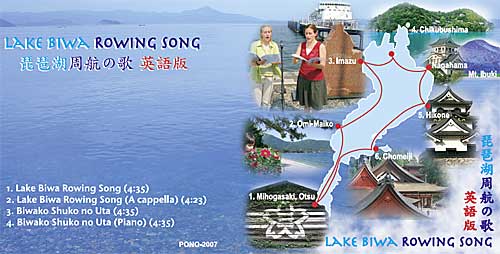Lake Biwa Rowing Song: Difference between revisions
No edit summary |
No edit summary |
||
| (28 intermediate revisions by the same user not shown) | |||
| Line 1: | Line 1: | ||
Download: [ | Download: [https://shiga-ken.com/docs/musicsheet-e.pdf Music sheet] | [[Lake Biwa Rowing Song Lyrics|English lyrics]] | [https://photoguide.jp/pix/index.php?cat=273 Photos] | ||
[[Biwako Shuko no Uta|日本語ページ]] | [[Biwako Shuko no Uta|日本語ページ]] | ||
by [[Philbert Ono]], ''Updated: | by [[Philbert Ono]], ''Updated: June 12, 2023'' | ||
<HTML> | <HTML> | ||
| Line 9: | Line 9: | ||
</HTML> | </HTML> | ||
Shiga Prefecture's most famous song is called ''Biwako Shuko no Uta'' (琵琶湖周航の歌) or ''Lake Biwa Rowing Song''. Composed in 1917 by members of a collegiate rowing club in Kyoto, the song is about a boat-rowing trip around [[Lake Biwa]], Japan's largest lake. The song has six verses taking you around the lake and each verse mentions a different scenic place along the rowing route. Shiga's famous places and colorful sights are mentioned by name. At the same time, the song expresses the journey of life itself with an infectious melody. | |||
The song is well-known in Japan and a staple in the repertoire of local choirs in Japan. It has been covered by numerous Japanese artists since the 1960s and became a major hit for singer Kato Tokiko in 1971. It's also one of Kyoto University's official songs and the official song of the Kyoto University Rowing Club. An English version was created in 2006 and released as a CD in June 2007. | |||
First listen to the song in English by watching the video embedded above or [https://youtu.be/9G94IppUiiE watching it on YouTube.] The video is also subtitled with the English lyrics. | |||
To listen to the song in Japanese, watch [https://www.youtube.com/watch?v=_b3WrfV0rMI&t=3233s this video clip] (complete with romanized and Japanese lyrics). | |||
[[File:20070808 1591s.JPG|thumb|800px|center|Replica of fixed-seat wooden boat similar to the one used in 1917. (Imazu Jr. High Rowing Club on Lake Biwa.)]] | |||
'''Lake Biwa rowing route''' | |||
[[File:Shigashukouta01.jpg|600px|thumb|right|Map of clockwise rowing route (red line) taken by Oguchi Taro and crewmates in June 1917. This map is part of the Verse 5 song monument in Hikone.]] | |||
In June 1917, seven boys from a university in Kyoto (which would merge with Kyoto University) went on a four-day rowing trip around Lake Biwa (''Biwako shuko''). They started from their boathouse in Otsu and rowed in a fixed-seat, wooden boat. They rowed to Omi-Maiko (also called Omatsu)*, Imazu*, Chikubushima island, Nagahama, Hikone*, and Chomeiji (Omi-Hachiman) before returning to Otsu. (Asterisked places are where they lodged overnight.) | |||
The | The red line on the map was their rowing route. It was during this rowing trip when they came up with the song that became ''Biwako Shuko no Uta.'' | ||
The dotted blue line on the map shows a longer route taken in 1893 when their rowing club rowed around the lake for the first time. On that first rowing excursion, 21 of them rowed around the lake in three boats, taking four nights and five days. It was the start of the school's annual summer tradition of rowing around Lake Biwa. This tradition still continues with the Kyoto University Rowing Club which inherited the old rowing club. | |||
'''Rowing destinations''' | |||
1. [[Otsu,_Shiga|Otsu]] - Capital city of Shiga Prefecture adjacent to Kyoto city. The rowing club's boathouse was on the waterfront near the Biwako Canal inlet. Near [[Hama-Otsu Station]]. | |||
2. [https://photoguide.jp/pix/thumbnails.php?album=28 Omi-Maiko (Omatsu)] - Lake Biwa's most beautiful white-sand beach lined with pine trees. Even today, it's popular with summer beachgoers and lodging. In 1917, it was a desolate place where the boys played on the beach and lodged overnight. Although the song mentions a camellia bush, there's no camellia there today. Near JR [[Omi-Maiko Station]] (JR Kosei line). | |||
On | 3. [https://photoguide.jp/pix/thumbnails.php?album=127 Imazu] - On the northeast lake shore, Imazu was another slow, scenic lakeside place. The boys stayed here overnight and famously composed the rowing song. One of the rowers, [[Oguchi Taro]], revealed that he was writing a rowing song. He shared the lyrics with his boatmates, and they matched the lyrics to the melody of a song called ''Hitsuji-gusa'' (Water Lilies) by Yoshida Chiaki. Imazu is therefore considered to be the birthplace of the song. Near JR [[Omi-Imazu Station]] (JR Kosei Line). | ||
4. [https://photoguide.jp/pix/thumbnails.php?album=18 Chikubushima] - Small, sacred island in the middle of northern Lake Biwa. Home of the Hogonji Buddhist temple and Shinto shrine complex. An ideal rest stop while crossing the lake to the western shore. The temple (whose gate is a National Treasure) was recently renovated with intricate wood carvings repainted in vivid colors. | |||
5. [[Nagahama,_Shiga|Nagahama]] - Former castle town with lots of history. Today, it's a major tourist town with Nagahama Castle (reconstructed), shopping arcade, and float festival in spring. Mt. Ibuki (Shiga's highest mountain) also stands tall behind Nagahama. | |||
6. [[Hikone,_Shiga|Hikone]] - Home of Shiga's most famous castle and National Treasure, Hikone Castle. The castle is on a hill and rowers can see the castle from the lake. The boys lodged in Hikone on their third and final night. | |||
7. [https://photoguide.jp/pix/thumbnails.php?album=147 Chomeiji] - Hillside temple in [[Omihachiman,_Shiga|Omi-Hachiman]]. The boys must have had much energy to climb up the 800 stone steps to the temple. Today, you can go up almost to the top by car or taxi instead. | |||
'''English version''' | |||
[[File:ShigaBiwakoCD.jpg|200px|thumb|right|CD cover.]] | |||
In May 2006, I created an English version called ''Lake Biwa Rowing Song'' with the hope that it would help promote Shiga. The English lyrics closely match the meaning and melody of the original Japanese song. We first unveiled it to the public on June 3, 2006 at Imazu Port in [[Takashima, Shiga]]. We also produced our ''Lake Biwa Rowing Song'' CD which went on sale on June 16, 2007 (now out of print). The English song and CD were very well received in Shiga. (Details below.) | |||
After listening to the song or reading the lyrics, you will wonder about the strange or mysterious things mentioned in the song. I will try to give the best explanation below along with some imagery and AI-generated illustrations. | |||
The English lyrics are followed by the Japanese lyrics and romanization. To see or print out the English lyrics only (no annotations), [[Lake Biwa Rowing Song Lyrics|click here.]] | |||
'''Song monuments''' | |||
Shiga has a song monument for each of the six verses of ''Biwako Shuko no Uta.'' They are at the respective place mentioned in the verse. Photos and directions to the monuments are provided for each verse below. | |||
Being the birthplace of the song, Imazu also has a song museum called [https://shiga-ken.com/blog/2022/01/lake-biwa-rowing-song-museum/ Lake Biwa Rowing Song Museum] (琵琶湖周航の歌資料館) dedicated to the song. The original museum opened in 1998, but it closed after 20 years due to the aging building and moved to a nearby building in Imazu on April 1, 2020. | |||
=English Lyrics Meaning= | |||
==Verse 1 Lyrics (Otsu)== | ==Verse 1 Lyrics (Otsu)== | ||
[[ | [[File:01-IMG 2976a.jpg|500px|right|"Rising mist evaporates, ripples come and go."]] | ||
English lyrics: Philbert Ono | English lyrics: Philbert Ono | ||
| Line 176: | Line 85: | ||
The capital (Miyako) of Shiga is Otsu, where they departed from Mihogasaki boat harbor on June 27, 1917. The kanji for "Umi" is normally pronounced "mizu-umi" (lake). For some reason, the kanji characters for "Shiga" is incorrect for Shiga Prefecture. The school logo was a cherry blossom with the character "san"at the center meaning "three" and the three stripes denoting the No. 3 High School (Dai-san Koto Gakko) which later became part of Kyoto University. | The capital (Miyako) of Shiga is Otsu, where they departed from Mihogasaki boat harbor on June 27, 1917. The kanji for "Umi" is normally pronounced "mizu-umi" (lake). For some reason, the kanji characters for "Shiga" is incorrect for Shiga Prefecture. The school logo was a cherry blossom with the character "san"at the center meaning "three" and the three stripes denoting the No. 3 High School (Dai-san Koto Gakko) which later became part of Kyoto University. | ||
*''[ | <gallery widths=400px heights=400px> | ||
*''[ | File:BiwakoRowingVerse1_children.jpg|Children of the lake... | ||
File:BiwakoRowingVerse1_rowers.jpg|Rising mist & ripples... | |||
</gallery> | |||
===Verse 1 Monument=== | |||
<gallery widths=400px heights=250px> | |||
File:01-20050525-IMG_2884.JPG|Verse 1 Song Monument in Otsu (Mihogasaki). In 1973, this was the first monument built for the song. The song's first and most famous line, "Ware wa Umi no Ko" is written. われは湖の子 | |||
File:01-20050525-IMG_2917.JPG|Second monument with the entire song lyrics. | |||
</gallery> | |||
'''Verse 1 Monument Directions (Otsu):''' From JR [[Otsu Station]], take a bus to Mihogasaki. It's about 10 min. Or you can easily walk it from [[Biwako Hama-Otsu Station]]. Just walk on the main road toward the race boat arena. There will be a small marina on the right. Right after passing the marina, turn right into the small road. There will be a small park on the right. The monument is there. There are two stone monuments. It might be roped off and you're not supposed to enter the park. While you're there, walk around the marina and see the boathouse with the [http://www.photoguide.jp/pix/displayimage.php?album=155&pos=7 cherry blossom logo with three stripes]. That's the logo of the school and the place where the boys left for the rowing trip in 1917. Otsu Station also has a tourist information office where you can obtain directions and a map. | |||
Google Map (Verse 1 Monument): https://goo.gl/maps/MRQDmxw2Wrky7xKf7 | |||
*''[https://photoguide.jp/pix/thumbnails.php?album=155 More song pictures here].'' | |||
*''[https://photoguide.jp/pix/index.php?cat=19 More Otsu pictures here].'' | |||
==Verse 2 Lyrics (Omatsu/Omi-Maiko)== | ==Verse 2 Lyrics (Omatsu/Omi-Maiko)== | ||
[[Image:shigabiwakoutav2.jpg|thumb| | [[Image:shigabiwakoutav2.jpg|thumb|500px|right|"Pine trees are very green, on sands very white."]] | ||
Pine trees are very green, on sands very white.<br /> | Pine trees are very green, on sands very white.<br /> | ||
Omatsugasato is, a young maiden's home.<br /> | Omatsugasato is, a young maiden's home.<br /> | ||
| Line 206: | Line 130: | ||
This verse symbolizes one's youth with all its trials and tribulations including falling in love and heartbreak. The green pines and white sand might symbolize freshness, youth, purity, and innocence. | This verse symbolizes one's youth with all its trials and tribulations including falling in love and heartbreak. The green pines and white sand might symbolize freshness, youth, purity, and innocence. | ||
''[ | <gallery widths=400px heights=400px> | ||
File:BiwakoRowingVerse2_beach.jpg|Green pines, white sands... | |||
File:BiwakoRowingVerse2_camellia.jpg|Red camellia hides her teary face... | |||
</gallery> | |||
===Verse 2 Monument=== | |||
<gallery widths=400px heights=250px> | |||
File:02-20180421-0048.jpg|Verse 2 Song Monument in Omi-Maiko (Omatsu). On the lake shore in front of Hotel Biwa Lake Otsuka. | |||
File:02-20180421-0050.jpg|Verse 2 Song Monument in inscribed with verse 2. Built in March 1989. | |||
</gallery> | |||
'''Verse 2 Monument Directions (Omi-Maiko):''' Near [[Omi-Maiko Station]] on the JR [[Kosei Line]]. After exiting the station, walk left toward Kitahama. Then get to the lake shore and walk along the lakeshore road until you see the monument under a large tree right on the shore. It is in front of Hotel Biwa Lake Otsuka. | |||
Google Map (Verse 2): https://goo.gl/maps/ZQYndf3dLyK2p2XX7 | |||
''[https://photoguide.jp/pix/thumbnails.php?album=28 More pictures of Omi-Maiko here].'' | |||
==Verse 3 Lyrics (Imazu)== | ==Verse 3 Lyrics (Imazu)== | ||
[[Image:shigabiwakoutav3.jpg|thumb| | [[Image:shigabiwakoutav3.jpg|thumb|500px|right|"On shore we see red fire, brings back memories."]] | ||
We drift from wave to wave, straying aimlessly.<br /> | We drift from wave to wave, straying aimlessly.<br /> | ||
On shore we see red fire, brings back memories.<br /> | On shore we see red fire, brings back memories.<br /> | ||
| Line 239: | Line 178: | ||
[[Nagahama, Shiga|Nagahama]] is one of Shiga's largest cities, anchoring the northeast corner of Lake Biwa. It also has a port where you can take a boat to Chikubushima. | [[Nagahama, Shiga|Nagahama]] is one of Shiga's largest cities, anchoring the northeast corner of Lake Biwa. It also has a port where you can take a boat to Chikubushima. | ||
''[ | <gallery widths=400px heights=400px> | ||
File:BiwakoRowingVerse3 drifting.jpg|Drifting and straying aimlessly... | |||
File:BiwakoRowingVerse3 redlamp.jpg|Red fire on shore... | |||
</gallery> | |||
===Verse 3 Monuments=== | |||
Verse 3 monuments are in both Imazu and Nagahama. | |||
<gallery widths=400px heights=250px> | |||
File:03-20070616-IMG_5325.JPG|Imazu Port has two monuments. In the foreground is the monument for the entire song. At the end of the dock, there's the Verse 3 Song Monument in the shape of a lamp. This dock is used by boats going to Chikubushima. | |||
File:03-20070601_3356.JPG|Verse 3 Song Monument at the end of the pier at Imazu Port. At night, this lamp lights up in red. Chikubushima island and Mt. Ibuki are in the background. | |||
File:03-20221112 4855.jpg|Verse 3 Song Monument in Hokoen Park, Nagahama. It's a stone bench engraved with verse 3. | |||
File:03-20170626-0860.jpg|Former Verse 3 Song Monument in Hokoen Park, Nagahama. It was made of glass, but it cracked and was replaced by the stone bench. | |||
</gallery> | |||
'''Verse 3 Monument and song museum Directions (Imazu):''' Near [[Omi-Imazu Station]] on the JR [[Kosei Line]]. Get out the east exit and walk on the main road toward the lake. You will soon see Imazu Port. Near the water, you can see the "red fire" song monument. On the very end of the pier, and you can see the lamp monument. (The pier might be closed off if there is no boat, so you may have to ask permission to walk on the pier.) Omi-Imazu Station also has a tourist information office where you can obtain directions and a map. | |||
Also visit the [https://shiga-ken.com/blog/2022/01/lake-biwa-rowing-song-museum/ Lake Biwa Rowing Song Museum] on a side road from the main road between the train station and lakeshore. | |||
Google Map(Verse 3 monument in Imazu): https://goo.gl/maps/WnH5nQAwNmNihkpH6 | |||
'''Verse 3 Monument (Nagahama) Directions:''' Near Nagahama Castle in Hokoen Park (Ho Park) facing the lake shore. Short walk from [[Nagahama Station]]. The newest song monument unveiled on June 25, 2017 for the 100th anniversary of the song. It was a park bench made of solid glass in Nagahama. It was shaped like a boat with a wavy surface. You could sit on it as a park bench and watch the sunset. However, the glass bench later cracked and the monument was replaced in the same location with one made of white stone sculpted in a similar wavy shape as a park bench. | |||
Google Map(Verse 3 monument in Nagahama): https://goo.gl/maps/hWGugEcBVpKsSmpP7 | |||
''[https://photoguide.jp/pix/thumbnails.php?album=127 More pictures of Imazu here].'' | |||
==Verse 4 Lyrics (Chikubushima== | ==Verse 4 Lyrics (Chikubushima== | ||
[[Image:shigabiwakoutav4.jpg|thumb| | [[Image:shigabiwakoutav4.jpg|thumb|500px|right|Full of old-time stories, Chikubushima.]] | ||
Azure blue flower garden, revered coral shrine.<br /> | Azure blue flower garden, revered coral shrine.<br /> | ||
Full of old-time stories, Chikubushima.<br /> | Full of old-time stories, Chikubushima.<br /> | ||
| Line 268: | Line 231: | ||
Chikubushima is easily accessible by boat from Nagahama, Hikone, and Imazu. It is a highly recommended sightseeing spot. | Chikubushima is easily accessible by boat from Nagahama, Hikone, and Imazu. It is a highly recommended sightseeing spot. | ||
''[ | <gallery widths=400px heights=400px> | ||
File:BiwakoRowingVerse4_coralshrine.jpg|Coral shrine in the lake... | |||
File:BiwakoRowingVerse4 buddhahands.jpg|In Buddha's hands... | |||
</gallery> | |||
===Verse 4 Monument=== | |||
<gallery widths=400px heights=250px> | |||
File:04-20210131_5489.JPG|Verse 4 Song Monument near the boat dock on Chikubushima island. Built in 1987 by Biwako Kisen, tour boat operator. | |||
File:04-20210131_5496.JPG|Back of the monument explains the song's background. | |||
</gallery> | |||
'''Verse 4 Monument Directions (Chikubushima):''' From Imazu Port, Hikone Port, or Nagahama Port, take a boat to Chikubushima island. The monument is right near the pier on the island. Hikone Port is accessible by bus from JR [[Hikone Station]], and Nagahama Port is walkable from JR [[Nagahama Station]]. Imazu Port is a short walk from JR [[Omi-Imazu Station]]. | |||
Google Map (四番の歌碑): https://goo.gl/maps/Wfr867sZEM4rvNxN6 | |||
''[https://photoguide.jp/pix/thumbnails.php?album=18 More pictures of Chikubushima here].'' | |||
==Verse 5 Lyrics (Hikone)== | ==Verse 5 Lyrics (Hikone)== | ||
[[Image:shigabiwakoutav5.jpg|thumb| | [[Image:shigabiwakoutav5.jpg|thumb|500px|right|"Abundant summer grasses, a moat still remains."]] | ||
Sharp arrows buried deeply, way into the ground.<br /> | Sharp arrows buried deeply, way into the ground.<br /> | ||
Abundant summer grasses, a moat still remains.<br /> | Abundant summer grasses, a moat still remains.<br /> | ||
| Line 293: | Line 271: | ||
Since 1973, various sponsors have been building stone monuments for the song. The respective settings of Otsu, Omatsu (Omi-Maiko), Imazu, Chikubushima, and Chomeiji all have a stone monument for their respective verse. But there has been no monument for this 5th verse, perhaps because no place name is mentioned. Finally, just recently in Oct. 2005, a stone monument for this 5th verse was unveiled in Hikone, near the port. | Since 1973, various sponsors have been building stone monuments for the song. The respective settings of Otsu, Omatsu (Omi-Maiko), Imazu, Chikubushima, and Chomeiji all have a stone monument for their respective verse. But there has been no monument for this 5th verse, perhaps because no place name is mentioned. Finally, just recently in Oct. 2005, a stone monument for this 5th verse was unveiled in Hikone, near the port. | ||
''[ | <gallery widths=400px heights=400px> | ||
File:BiwakoRowingVerse5 arrows.jpg|Arrows buried deeply... | |||
File:BiwakoRowingVerse5 oldcastle.jpg|Standing in an old castle... | |||
</gallery> | |||
===Verse 5 Monument=== | |||
<gallery widths=250px heights=180px> | |||
File:05-IMG_0420.jpg|Verse 5 Song Monument, Hikone Port. There are three stones. The left stone is inscribed with the entire song, and bigger stone on the right has the lyrics for verse 5. | |||
File:05-IMG_0404.jpg|Third stone has a map of the lake and rowing route. | |||
File:05-IMG_0438.jpg|Monument space. There might be weeds or wild grass growing here. | |||
</gallery> | |||
'''Verse 5 Monument Directions (Hikone):''' From JR [[Hikone Station]] on the JR [[Biwako Line]], take a bus to Hikone-ko Port. The monument is behind the boat terminal (where boats to Chikubushima embark) near the lake shore. If you visit the castle on the same day, you can walk to the port from the castle. [[Hikone Station]] also has a tourist information office where you can obtain directions and a map. | |||
Google Map (Verse 5 monument): https://goo.gl/maps/Fw9nc4TuTdNPLTmY8 | |||
''[https://photoguide.jp/pix/thumbnails.php?album=25 More pictures of Hikone Castle here].'' | |||
==Verse 6 Lyrics (Chomeiji)== | ==Verse 6 Lyrics (Chomeiji)== | ||
[[Image:shigachomeiji.jpg|thumb| | [[Image:shigachomeiji.jpg|thumb|500px|right|Saigoku pilgrimage, Chomeiji.]] | ||
Saigoku pilgrimage, Chomeiji.<br /> | Saigoku pilgrimage, Chomeiji.<br /> | ||
Dispel this world's impureness, very faraway.<br /> | Dispel this world's impureness, very faraway.<br /> | ||
| Line 318: | Line 312: | ||
The English lyrics does not include this "10th temple" error which has been substituted by "pilgrimage." Interesting to note that choirs in Omi-Hachiman do not sing "Saigoku Juban" out of respect for Chomeiji, the city's most famous temple. Instead of "Juban," they sing "reijo" 礼所 which means pilgrimage place. Chomeiji's stone monument for this verse shows only the last two lines and omits the mistaken "10th Temple" line. | The English lyrics does not include this "10th temple" error which has been substituted by "pilgrimage." Interesting to note that choirs in Omi-Hachiman do not sing "Saigoku Juban" out of respect for Chomeiji, the city's most famous temple. Instead of "Juban," they sing "reijo" 礼所 which means pilgrimage place. Chomeiji's stone monument for this verse shows only the last two lines and omits the mistaken "10th Temple" line. | ||
From Chomeiji, they rowed westward back to Otsu. They could have well seen a golden sunset creating golden waves. It was exciting to be closer to home. These golden waves may also refer to the Pure Land of Buddhism, equivalent to Heaven. For many people, the last line (sung twice) is the favorite as it emotionally conveys camaraderie. Yes, this is a story that must be told. | From Chomeiji, they rowed westward back to Otsu. They could have well seen a golden sunset creating golden waves. It was exciting to be closer to home. These golden waves may also refer to the Pure Land of Buddhism, equivalent to Heaven. For many people, the last line (sung twice) is the favorite as it emotionally conveys camaraderie. Yes, this is a story that must be told. | ||
<gallery widths=400px heights=400px> | |||
File:BiwakoRowingVerse6 goldenwaves.jpg|Golden waves... | |||
File:BiwakoRowingVerse6 friends.jpg|Tell us my friends your stories... | |||
</gallery> | |||
===Verse 6 Monuments=== | |||
<gallery widths=400px heights=250px> | |||
File:06-IMG_3391.jpg|Verse 6 monument near Chomeiji Port. It omitted the "Saigoku juban" phrase. | |||
File:06-20170423_7943.jpg|Verse 6 monument at Chomeiji Temple. | |||
</gallery> | |||
'''Verse 6 Monuments Directions (Chomeiji, Omi-Hachiman):''' From [[Omi-Hachiman Station]] on the JR [[Biwako Line]], take a bus to Chomeiji. Takes about 20 min. Omi-Hachiman Station has a tourist information office where you can obtain directions and a map. You can also rent a bicycle at the station and follow the map to Chomeiji Port. The monument is in a small park in front of the port near the Chomeiji bus stop. | |||
Google Map (Verse 6 Monument at Chomeiji Port): https://goo.gl/maps/kdbqdvncns9mNazD8 | |||
The other Verse 6 monument is within the Chomeiji temple grounds. Climb the 800 steps (quite strenuous) to the temple or call a taxi to drive up near the top. | |||
Google Map (Verse 6 Monument at Chomeiji Temple): https://goo.gl/maps/H4GYxbrBQjrVjmAw6 | |||
''[https://photoguide.jp/pix/thumbnails.php?album=147 More pictures of Chomeiji here].'' | |||
= Composing the English Lyrics = | |||
<HTML> | |||
<table width="302" border="1" rules=all bordercolor="#9999cc" cellspacing="0" cellpadding="2" align="right"> | |||
<tr> | |||
<td><span class="plainlinks"><a href="https://shiga-ken.com/blog/2017/12/kyoto-universitys-biwako-shuko-no-uta-100th-anniversary-celebration/" class="external text" title="monument" rel="nofollow"><img src="https://shiga-ken.com/blog/wp-content/uploads/2017/12/20171125-0065a.jpg" alt="monument" /></a></span></td> | |||
</tr> | |||
<tr> | |||
<td align="left" valign="top" style="font-size: 90%;">English lyrics on Kyoto University's Biwako Shuko no Uta monument on the Yoshida-South Campus.</td> | |||
</tr> | |||
</table> | |||
</HTML> | |||
When making the English lyrics, I kept all the place names in the exact same position as in the original Japanese song. So if the Japanese and English versions of the song are sung at the same time, at least the place names would match exactly. This turned out to be a major boon for the English version. Words like Shiga, Omatsugasato, Imazu, Nagahama, Hira, and Ibuki are all sung in the same way as in the Japanese song. People familiar with the Japanese song can sing the place names in the English song in the same way as in the Japanese version. | |||
'' | The Japanese song has six verses with four lines each. Each line is sung as two parts, the first part has seven syllables and the second part has five syllables. For example, the first line: "Wa re wa U mi no Ko" (We're children of the lake) is seven syllables and "sa su ra i no" (off to wander 'round) has five syllables. Almost all the lines follow this 7-5 syllable pattern. When creating the English, it is ideal to match this 7-5 syllable pattern. | ||
At first, I simply created a 7-5 syllable pattern for each line. Later on, when I tried to sing such English lyrics, it did not sound right even though the number of syllables matched. I soon realized that the accent of each word also had to match the high and long notes in the melody. That put me back to the drawing board and I almost had to start all over again. The melody basically alternates between high/long and low notes for each syllable. And so the English also had to have alternating accents. Unlike translating haiku or tanka poetry where you just need to match the number of syllables, a translated song also requires accented syllables (or long vowels) at the right places. | |||
Almost all the lines start with the second syllable being accented. Therefore, for the first word in each line, I had to use a word whose second syllable was accented. Or use a single-syllable word followed by a word whose first syllable was accented. For example, "To'''day''' is '''I'''ma'''zu'''" is fine (accented syllables in bold), but "Is to'''day I'''ma'''zu'''" does not match the melody because the second syllable in the line is not accented. Since the second syllable of "to'''day'''" is accented, I can use it as the first word in the line, but I cannot use it as the second word because the accent is not on the first syllable "to." | |||
Verse | Another frequent problem was that the English words could be made much shorter than the Japanese. For example, Verse 2 says "Green pines on white sands" in Japanese. But this is too few syllables and I had to insert filler words to match the melody. This line then became "Pine trees are very green, on sands very white." | ||
Verse 5 also has "Arrows buried deeply" in Japanese. Being too short in English, this line was expanded to "Sharp arrows buried deeply, way into the ground." The English lyrics therefore have some filler words to increase the number of syllables to match the melody. Of course, when you do this, you are liable to change the meaning and stray from the meaning of the original song. So I carefully chose filler words which did not affect the meaning significantly. | |||
Matching the melody was tough enough, but matching the original meaning of the song at the same time was sometimes impossible. Especially when the meaning is not clear. Why does it say "coral shrine" when the lake has no coral? In such cases, I had to incorporate my own interpretation. I also declined to make the lyrics rhyme. I found it near impossible to make any words rhyme without changing the meaning too much. I think it sounds fine even if it does not rhyme. | |||
It is quite rare to create an English version of a Japanese song matching both the Japanese meaning and melody. For example, most Japanese anime theme songs converted into English do not match the meaning of the original Japanese. And remember the song "Sukiyaki" by Sakamoto Kyu? The English version created by A Taste of Honey (and later sung by other artists) does not match the meaning of the original Japanese song. | |||
=''Biwako Shuko no Uta'' Origin and History= | |||
<youtube>EtF3aKnXEX4</youtube> | |||
''*Video shows a dramatic Japanese reading of the birth of the song.'' | |||
''Biwako Shuko no Uta'' (琵琶湖周航の歌) is by far [[Shiga Prefecture]]'s most famous and popular song even though it is not the official prefectural song. I call it Shiga's "Hometown Anthem." "Biwako" means "Lake Biwa," "Shuko" means "cruise around," "no" is "of," and "Uta" is "song." The song is about a four-day, rowing trip around Lake Biwa undertaken on June 27, 1917 by seven college students. They belonged to the rowing club of an elite university in Kyoto called Dai-san Koto Gakko (No. 3 High School, shortened to "Dai-sanko" 第三高等学校) which later merged with Kyoto University. ("High school" in those days referred to universities before modern education reforms.) | |||
It was during a Lake Biwa rowing trip in June 1917 when the song was first completed. Although the Japanese lyrics are credited to rowing club member [[Oguchi Taro]] 小口太郎 (1897-1924) from [https://photoguide.jp/pix/index.php?cat=111 Okaya, Nagano Prefecture], a number of fellow boatmates and classmates also gave their own contributions to the lyrics. Oguchi had been working on the lyrics for some months before the lyrics were revealed to his rowing mates on June 28, 1917 at their lodge in Imazu. It was after dinner on the second day of their rowing trip, when a crewmate named Nakayasu Jiro exclaimed, "Hey everyone, listen up! Oguchi has written this song," and showed everyone the song. | |||
Then another crewmate named Taniguchi Kenryo, who knew a popular song called ''Hitsuji-gusa'' (Water Lilies) by [[Yoshida Chiaki]], began singing Oguchi's lyrics to Yoshida's melody. Since the melody went well with the words, the rowing crewmates sang the song together that night. It was the birth of ''Biwako Shuko no Uta.'' According to one legend, Oguchi had written the lyrics while rowing on that trip. However, several classmate witnesses say that Oguchi actually started writing the song from autumn the previous year, collaborating with a handful of other classmates. | |||
After that fateful rowing trip around the lake in 1917, the song was further refined and finalized after a series of meetings with fellow rowers and classmates. The entire song (six verses) was finally completed in 1918 after Oguchi's second rowing trip around the lake in late June (after final exams). The song was publicly announced at the start of the new school year in September 1918. It soon became popular among all the students. There was still no TV and no radio. There was no record either. The current, popular version today is slightly different as well, with a few different words and kanji characters now used in the song. | |||
[[File:WaterLilies1b.jpg|300px|thumb|right|Misty moonlight...]] | |||
The ''Hitsuji-gusa'' song was composed by a young [[Yoshida Chiaki]] 吉田千秋 (1895-1919) from Niigata Prefecture in 1915. The song was published in a music magazine that year and apparently became famous enough to be used with Oguchi's lyrics. Yoshida's song was actually his Japanese version of a 19th-century British children's poem or song called ''[[Yoshida Chiaki|Water Lilies]]'' (the first line reads "Misty moonlight faintly falling O'er the lake at even tide..."). The song is about water lilies holding firm even in rain, stormy weather, etc. The song is about holding fast in times of adversity. | |||
Instead of using the original ''Water Lilies'' melody, Yoshida composed his own melody to suit his Japanese lyrics. The melody was like a Christian hymn, evidence that Yoshida was influenced by his independent studies at a Christian church. It is a totally different melody from the original British ''Water Lilies'' song. But if you hear Yoshida's song, it becomes obvious that the melody was used in ''Biwako Shuko no Uta." "Biwako Shuko no Uta'' has Buddhist overtones, so it is interesting that the song is matched with a Christian hymn. [[Yoshida Chiaki]], who died at age 24, never met the songwriter Oguchi Taro who also died in his 20s. | |||
As the song circumnavigates the lake and mentions famous places in Shiga, the words also express symbolic meanings and sometimes unknown or mistaken meanings. The song is widely interpreted as describing the journey of life itself. (Details below.) | |||
Written by a bunch of college students, the song also expresses the youthful spirit they had while rowing around the lake. And like life itself, rowing around the big lake was a great adventure. The song also has an air of mystery due to a number of unknown meanings in the lyrics. | |||
Since the 1960s, the song has been recorded by many famous Japanese singers and groups such as Peggy Hayama, Miyako Harumi, Baisho Chieko, Frank Nagai, Kobayashi Akira, Mori Shin'ichi, Mori Masako, and Fuji Keiko. Nini Rosso even recorded a trumpet version. | |||
The song's popularity can be attributed to a number of things. Both the Japanese lyrics and melody strike a deep chord among those singing the song. The lyrics have metaphoric references to various stages of life. So for older people (especially the alumni of Dai-san Koto Gakko and Kyoto University), it brings back nostalgic memories of one's youth or one's hometown in Shiga. The melody itself is also nostalgic, infectious, and easy to sing. It is a tradition for people to form a circle shoulder-to-shoulder while singing the song. A special feeling of camaraderie emerges. | |||
<HTML> | <HTML> | ||
<table | <table width="302" border="1" rules=all bordercolor="#9999cc" cellspacing="0" cellpadding="2" align="center"> | ||
<tr> | |||
<td><span class="plainlinks"><a href="https://shiga-ken.com/blog/2017/12/kyoto-universitys-biwako-shuko-no-uta-100th-anniversary-celebration/" class="external text" title="monument" rel="nofollow"><img src="https://shiga-ken.com/blog/wp-content/uploads/2017/12/20171125-0074a.jpg" alt="monument" /></a></span></td> | |||
</tr> | |||
<tr> | |||
<td align="left" valign="top" style="font-size: 90%;">Kyoto University's Biwako Shuko no Uta monument (front side) unveiled on Nov. 25, 2017 on the Yoshida-South Campus.</td> | |||
</tr> | |||
</table> | |||
<tr | |||
<td><span class="plainlinks"><a href=" | |||
</ | |||
</td | |||
<tr | |||
<td | |||
</HTML> | </HTML> | ||
In 1971, it became a nationwide hit with singer Kato Tokiko's rendition. Today, the song remains dear to many people in Kyoto, Shiga, Nagano, and Niigata. Rowing club graduates of the old No. 3 High School (if any are still alive) and Kyoto University regard the song as a symbol of their youth and college years. It is also one of Kyoto University's official school songs. After [https://photoguide.jp/pix/thumbnails.php?album=367 rowing around Lake Biwa] and after every regatta, the Kyoto University Rowing Club form a circle shoulder-to-shoulder and sing the song. | |||
People in Shiga also sing the song at the end of parties or official gatherings. Most choirs in Shiga also sing the song, sometimes overseas as well. In Imazu, the so-called birthplace of the song, a choir competiton is held for this song every June (since 1997). Karaoke bars nationwide also include this song in their song collections. | |||
The song is often confused with another Lake Biwa song called ''[[Biwako Aika]]'' 琵琶湖哀歌 (Lake Biwa Elegy). This mournful song was dedicated to the eight college rowers from Kanazawa, [[Ishikawa Prefecture]] and three rowers from Kyoto who were practicing in waters off Imazu died when they encountered strong winds from the mountains on April 6, 1941. | |||
Shiga Prefecture also has song monuments (see below for photos and a map) for the song and each of the six verses ([https://photoguide.jp/pix/thumbnails.php?album=516 photos here]). There's even a museum ([https://shiga-ken.com/blog/2022/01/lake-biwa-rowing-song-museum/ Lake Biwa Rowing Song Museum]) in Imazu dedicated to the song. Okaya city on the shores of Lake Suwa in Nagano Prefecture, the birthplace of the song's composer, [[Oguchi Taro]], also has a song monument and bronze statue of him. | |||
However, we cannot ignore the fact that the song is no longer officially taught in schools in Shiga. So these days, fewer kids and young people in Shiga know about the song. This is alarming because hometown songs, dances, and music are essential to promote one's identity and attachment to one's hometown. Shiga has very few homegrown music and dance, and having this famous song fall into obscurity in Shiga would be a major loss for local culture. Being from Hawaii, rich with hometown songs and dances that are constantly perpetuated to the children, I cannot imagine having Biwako Shuko no Uta fade away in Shiga. | |||
A number of prominent people in Shiga have recognized this problem and are working to rectify it. A volunteer organization was recently formed in Imazu to propagate the song. And in 2017, for the song's 100th anniversary, former Shiga Governor Kada Yukiko and singer Kato Tokiko organized the Biwako Music Festival featuring famous artists and local students to sing the song on stage. The 1st Biwako Music Festival was held on June 30, 2017 at Biwako Hall in Otsu. They hope to make it an annual music event traveling to a different venue around the lake each year. In 2018, it was held in Wani (near Omi-Maiko), followed by Imazu in 2019, Nagahama in 2022 (postponed in 2020 and 2021 due to COVID-19), Hikone in 2023, and Omi-Hachiman in 2024. A traveling concert like the song itself. | |||
In 2017, the 100th anniversary celebration for the song took many forms in both Shiga and at Kyoto University. In late June 2017, a four-day rowing trip (named ''Nazori Shuko'') around Lake Biwa on three rowing boats was held by Kyoto University Rowing Club alumni. It was followed by a big concert at Biwako Hall in Otsu. ([https://shiga-ken.com/blog/2017/08/biwako-shuko-no-uta-100th-anniversary/ Photos here.]) And in Nov. 2017, Kyoto University held its own celebration on campus by unveiling a new song monument and holding a lecture session and music festival concert. The new song monument includes the English lyrics. The one and only bilingual song monument, maybe in all of Japan. ([https://shiga-ken.com/blog/2017/12/kyoto-universitys-biwako-shuko-no-uta-100th-anniversary-celebration/ Details here.]) | |||
Here's my 66-min. video of Kyoto University's celebration: | |||
<HTML> | <HTML> | ||
< | <iframe width="640" height="360" src="https://www.youtube.com/embed/_b3WrfV0rMI?rel=0" frameborder="0" gesture="media" allow="encrypted-media" allowfullscreen></iframe> | ||
</HTML> | |||
= The Making of ''Lake Biwa Rowing Song'' in English= | |||
<HTML> | |||
<iframe width="640" height="360" src="https://www.youtube.com/embed/gOUwlb6P_9s?rel=0" frameborder="0" allowfullscreen></iframe> | |||
</HTML> | </HTML> | ||
=== Song | I first heard ''Biwako Shuko no Uta'' in May 2004 in [https://photoguide.jp/pix/index.php?cat=111 Okaya, Nagano Prefecture] when I was there to photograph the [https://photoguide.jp/pix/index.php?cat=112 Onbashira Festival.] Okaya is a lakeside city fronting Lake Suwa. I was walking along the lakeshore where I soon came across a song monument and a large statue of [[Oguchi Taro]] who was a native of Okaya. The song monument was engraved with the lyrics and I was intrigued by all the Shiga places it mentioned. Two months later, I went to Shiga and visited the [https://shiga-ken.com/blog/2022/01/lake-biwa-rowing-song-museum/ Lake Biwa Rowing Song Museum] in Imazu, a small lakeside town in the northwestern corner of Lake Biwa. The more I learned about the song, the more fascinating it became. | ||
I found out that there were stone monuments for the song in various locations around the lake (see list below). I started visiting and photographing all these monuments and the places mentioned in the song. In autumn 2005, I held a small exhibition in Otsu (in Shiga Kaikan, across from the prefectural government) to show photos of the song monuments and places appearing in the song. I also explained the song in English. | |||
That's when an Asahi Shimbun newspaper reporter saw my exhibition and published a story about it. Some rowing club alumni who saw the article gave me their support and encouragement to create an English version, so I started working on it in my spare time. Originally, I had wanted to work and consult with multiple volunteers to create the English song. However, since no one answered my call (via the newspaper article) for collaborators, I worked alone. This probably was the most efficient way. I also created a web page explaining the song in English. It was just around the time I started my new website called [https://shiga-ken.com shiga-ken.com] in 2005. | |||
Online, I found a few literal English translations of the Japanese lyrics done by native Japanese, but they were only for explanatory purposes and none of them matched the melody. There was no true English version of the song matching the melody composed by Yoshida Chiaki. As I was working on the English version, I wondered if I could find someone to sing it when I finish the song. I'm not a singer, so I couldn't sing it. | |||
Then in late Jan. 2006, I got an email from Jamie Thompson working as an ALT on the JET Program in the city of [[Konan,_Shiga|Konan]]. She asked for directions to the song monuments. Turns out that she was a member of a choir in Konan, so she knew and loved the song. I asked her if she could sing the song after I finish it. "I'd be thrilled to!" she said. Not only that, she had a twin sister (Megan) working as an ALT in Marugame, [[Kagawa Prefecture]] who could also sing. So suddenly, I got two singers! This proved to be a very lucky development. | |||
In early May 2006, I finally met Jamie and Megan for the first time in Otsu. I took them to see four song monuments (Otsu, Imazu, Chikubushima, and Hikone). I also heard them sing together for the first time and was blown away. Yep, they could sing alright. Meeting them really boosted my morale and I feverishly worked on finishing the English version. I soon finished it, and it was unveiled it to the public by [https://photoguide.jp/pix/thumbnails.php?album=517 Jamie and Megan singing it on June 3, 2006] at Imazu, Shiga Prefecture. | |||
<gallery widths=400px heights=300px> | |||
File:Shigaimazuthompson.jpg|Jamie and Megan Thompson sing Lake Biwa Rowing Song in English in public for the first time to introduce the song to the world on June 3, 2006 next to the song monument at Imazu Port, Takashima, Shiga Prefecture. They also sang Biwako Shuko no Uta in Japanese. | |||
File:Shigasongcruise1.jpg|Jamie and Megan Thompson sing "Lake Biwa Rowing Song" at the Verse 4 song monument on Chikubushima on June 16, 2007. | |||
</gallery> | |||
The unveiling of the English song was covered by the local [https://photoguide.jp/pix/displayimage.php?album=587&pid=17370#top_display_media Asahi Shimbun], [https://photoguide.jp/pix/displayimage.php?album=587&pid=17371#top_display_media Mainichi Shimbun], and [https://photoguide.jp/pix/displayimage.php?album=587&pid=17372#top_display_media Yomiuri Shimbun] newspapers in Shiga. The Nagoya-based [https://photoguide.jp/pix/displayimage.php?album=587&pid=17369#top_display_media Chunichi Shimbun] newspaper covered the song's photo exhibition I held at the song museum at the same time in June 2006. Later, KBS Radio based in Kyoto and Shiga interviewed me live via telephone, and NHK Radio also introduced the song. We had very good press coverage. | |||
I held several [https://photoguide.jp/pix/thumbnails.php?album=518 photo exhibitions] in 2006 and 2007 to explain the English lyrics and show pictures of the places mentioned in the song and the [https://photoguide.jp/pix/thumbnails.php?album=516 song monuments]. Exhibitions were held at venues like [https://shiga-ken.com/blog/2022/01/lake-biwa-rowing-song-museum/ Lake Biwa Rowing Song Museum] (Biwako Shuko no Uta Shiryokan) (twice), Biwa Public Library in Nagahama, Yokaichi Public Library in Higashi-Omi, Lucci Plaza in Maibara, and Imazu Public Library. | |||
Another major miracle and highlight happened on Nov. 26, 2006. Jamie and Megan Thompson was one of 20 contestants (selected from among hundreds or maybe thousands of applicants) who appeared on the [https://photoguide.jp/pix/displayimage.php?album=517&pos=4 NHK TV Nodo Jiman amateur singing contest]. They sang the song in English in front of a live audience as well as on national TV. Guest singer Fuji Ayako exclaimed how beautiful the harmony of Jamie and Megan's voices was. | |||
On Feb. 25, 2007, Jamie entered a [https://photoguide.jp/pix/displayimage.php?album=517&pos=12 Japanese speech contest for foreigners in Shiga] and talked about the song. Her speech won 1st place. | |||
On June 16, 2007, we finally made our CD. It went on sale (800 yen) for the first time during a [https://photoguide.jp/pix/thumbnails.php?album=581 Lake Biwa cruise] where Jamie and Megan sang the song on the boat and on shore on Chikubushima island. The chartered cruise was held to mark the song's 90th anniversary. On the next day, June 17, 2007, Jamie and Megan appeared on the [https://photoguide.jp/pix/thumbnails.php?album=582 11th Biwako Shuko no Uta choir contest] as guest singers. | |||
On April 16, 2017, Jamie and Megan Thompson visited Japan together for the first time in eight years and we held a reunion concert at Imazu, performing both at Imazu Port and the [https://shiga-ken.com/blog/2022/01/lake-biwa-rowing-song-museum/ Lake Biwa Rowing Song Museum]. (The [https://youtu.be/9G94IppUiiE resulting video is here] and at the top of this page.) We did it to celebrate the song's 100th anniversary. | |||
On Nov. 25, 2017, Kyoto University unveiled a new song monument on campus. I was greatly honored to see the monument include my English lyrics. ([https://shiga-ken.com/blog/2017/12/kyoto-universitys-biwako-shuko-no-uta-100th-anniversary-celebration/ Details here.]) | |||
I donated the CD to Shiga's public libraries, local boards of education, international associations, tourism associations, and universities. | |||
I'm also putting this song into the public domain. Anyone can copy, record, and reproduce the song. I only ask that my name (Philbert Ono) be credited for the English lyrics. | |||
*'''About the singers:''' Twin sisters Jamie and Megan Thompson are from Normal, Illinois, USA. They worked as Assistant Language Teachers in the JET Program and were in Japan from July 2004 to July 2009. Older sister Jamie was based in Konan, Shiga Prefecture until July 2008 when she transferred to Hino, Shiga where she taught English at a junior high school. She was also a member of the local choir which is how she first heard and fell in love with the song. Megan was in Marugame, Kagawa Prefecture, also in a local choir, and she learned the song from her sister in Shiga whom she often visited. Both have been singing in choirs since childhood. I could not have met a better and more suitable pair of singers to sing and record the song. | |||
<gallery widths=400px heights=250px> | |||
File:Shiganodojiman.jpg|Jamie and Megan sing the song in English on NHK TV's "Nodo Jiman" amateur singing contest on Nov. 26, 2006 in Mitoyo, Kagawa Pref. They were one of the five finalists (gogaku) out of the 20 entrants. | |||
File:Shigasongcruise2.jpg|June 16, 2007 was when our CD went on sale. It also coincided with a Lake Biwa charter cruise held to mark the 90th anniversary of the song. Jamie and Megan Thompson sing Lake Biwa Rowing Song in the boat. | |||
File:Shigachoircontest1.jpg|At the 11th Biwako Shuko no Uta choir contest on June 17, 2007 in Imazu, Shiga, Jamie and Megan Thompson sing ''Lake Biwa Rowing Song.'' | |||
File:20071020 2739s.jpg|On Oct. 20, 2007 at the Umizukuri Boat Festa in Ogoto, Otsu, a mini concert was held with reed flute (yoshibue) players and Jamie singing the song in English. Shiga Governor Kada Yukiko threw a surprise and went on stage to sing in English with Jamie. A great honor. | |||
</gallery> | |||
= Other Song Monuments & Museums = | |||
<html> | <html> | ||
<iframe src="https://www.google.com/maps/d/embed?mid=1Tfz1R51er-qZEx5FybiXyvNfFOY" width="640" height="480"></iframe> | <iframe src="https://www.google.com/maps/d/embed?mid=1Tfz1R51er-qZEx5FybiXyvNfFOY" width="640" height="480"></iframe> | ||
</html> | </html> | ||
Besides song monuments in Shiga, there are monuments in Okaya, Nagano and Kyoto University and a song museum in Imazu, Takashima, Shiga. | |||
<gallery widths=250px heights=180px> | |||
File:naganookayaoguchitaro2.jpg|Oguchi Taro Song Monument built on the shore of Lake Suwa in 1988 to mark his 90th birthday. | |||
File:20070123 3603.JPG|Oguchi Taro statue. | |||
File:20040508-127 2776as.jpg|Oguchi Taro monument. Details here:https://photoguide.jp/pix/thumbnails.php?album=182 | |||
</gallery> | |||
In Okaya, Nagano Prefecture on the shore of Lake Suwa, there's a statue of song composer [[Oguchi Taro]] and a song monument. The monument has a music speaker from which you can hear the song and a plaque showing the entire lyrics. Built in 1988 by the city of Okaya to mark Oguchi's 90th birthday anniversary. | |||
''' | '''Directions to Oguchi Taro Song Monument (Okaya, Nagano):''' Short walk from [https://goo.gl/maps/VU9TFBXdKpGRhjjC9 JR Okaya Station]. Walk toward the shore of Lake Suwa. The monument is near the mouth of Tenryu River. See map above (scroll to Nagano Prefecture). | ||
<gallery widths=250px heights=180px> | |||
File:20071127 9364s.JPG|[https://www.city.agano.niigata.jp/kanko_bunka_sports/rekishi_bunkazai/4/4/index.html Yoshida Togo Memorial Museum] in Agano, Niigata. | |||
File:20071127 9369s.JPG|Entrance to Yoshida Togo Memorial Museum. | |||
File:20070616 5539s.JPG|Yoshida Chiaki's accordion. | |||
</gallery> | |||
In Agano, Niigata Prefecture, the [https://photoguide.jp/pix/thumbnails.php?album=613 Yoshida Togo Memorial Museum] ([https://www.city.agano.niigata.jp/kanko_bunka_sports/rekishi_bunkazai/4/4/index.html 吉田東伍記念博物館]) dedicated to Yoshida Chiaki's father Togo includes a small exhibit for Chiaki. | |||
''' | '''Directions to Yoshida Togo Memorial Museum (Agano, Niigata):''' [https://goo.gl/maps/5iL3a4fYHxU5TzBD7 JR Niitsu Station] is the closest station for a 15-min. taxi ride to the museum. Map: https://goo.gl/maps/ibR2YuL6ZEbTuXPo9 Web page: https://www.city.agano.niigata.jp/kanko_bunka_sports/rekishi_bunkazai/4/4/index.html | ||
<gallery widths=250px heights=180px> | |||
File:090-20210131 1011a.jpg|Lake Biwa Rowing Song Museum (Imazu Higashi Community Center, 1st floor) | |||
File:20210131 1019s.jpg|Lake Biwa Rowing Song Museum. | |||
File:095-20210131 1043.jpg|Oguchi Taro exhibit. Details: https://shiga-ken.com/blog/2022/01/lake-biwa-rowing-song-museum/ | |||
</gallery> | |||
Being the birthplace of the song, Imazu in Takashima, Shiga has the [https://shiga-ken.com/blog/2022/01/lake-biwa-rowing-song-museum/ Lake Biwa Rowing Song Museum] (琵琶湖周航の歌資料館) dedicated to the song. The original museum opened in 1998, but it closed after 20 years due to the aging building and moved to a nearby building in Imazu on April 1, 2020. It retains most all the exhibits of the old museum. Near JR Omi-Imazu Station. | |||
<gallery widths=400px heights=250px> | |||
File:20171125-0074a.jpg|Kyoto University's bilingual song monument. Yoshida Minami Campus. | |||
File:20171125-0065a.jpg|Back side has English. | |||
</gallery> | |||
''' | '''Directions to Kyoto University:''' From JR [[Kyoto Station]]'s Karasuma side (north side with Kyoto Tower), go to bus stop D2 and catch the No. 206 bus bound for "Gion Via Kiyomizu-dera Temple/Kitaoji Station" (三十三間堂・清水寺・祇園・百万遍). The bus leaves every 15 min. or so ([http://www2.city.kyoto.lg.jp/kotsu/busdia/hyperdia/061218.htm bus schedule here]), but it can be very crowded. The ride takes abut 30 min. Get off at "Kyodai Seimon-mae" (京大正門前). | ||
Cross the big road (Higashi-Oji-dori) and walk along Higashi-Ichijo street. The main Yoshida Campus will be on the left while the Yoshida-Minami Campus will be on the right. Enter the Yoshida-Minami Campus and walk to the central courtyard area. (From Kyoto Station, there is also an express bus (京大快速) to Kyoto University Hospital from bus stop D3, but it runs only at certain times on weekdays, mainly in the morning and mid-afternoon ([http://www2.city.kyoto.lg.jp/kotsu/busdia/hyperdia/061249.htm bus schedule here]). | |||
<HTML> | <HTML> | ||
< | <blockquote class="twitter-video" data-lang="en"><p lang="ja" dir="ltr">A new song monument to mark the 100th anniversary of Biwako Shuko no Uta (Lake Biwa Rowing Song) was unveiled at Kyoto University's Yoshida-South Campus in Kyoto on Nov. 25, 2017. It's in both Japanese & English. Watch this short video clip. 「琵琶湖周航の歌」100周年記念碑除幕式 <a href="https://t.co/wAUT0vsBap">pic.twitter.com/wAUT0vsBap</a></p>— Shiga Headlines (@ShigaHeadlines) <a href="https://twitter.com/ShigaHeadlines/status/934697137694109696?ref_src=twsrc%5Etfw">November 26, 2017</a></blockquote> <script async src="https://platform.twitter.com/widgets.js" charset="utf-8"></script> | ||
</HTML> | </HTML> | ||
[https://photoguide.jp/pix/thumbnails.php?album=516 More photos of song monuments.] | |||
= Trivia = | |||
[[ | [[File:20070808_1144s.JPG|300px|thumb|right|Fixed-seat boat.]] | ||
*On April 1, 1893, the rowing club of the Dai-san Koto Gakko (No. 3 High School 第三高等学校) in Kyoto held a boat-launching ceremony at Mihogasaki pier in Otsu and floated three new, fixed-seat racing row boats developed by Tokyo Imperial University. Seating six crew each, it was the first time these new boats went into the water in the Kansai region. Later after a bon voyage ceremony at 1 pm, 21 crewmates yelled "banzai" three times and started the school's annual tradition of rowing around Lake Biwa. | *On April 1, 1893, the rowing club of the Dai-san Koto Gakko (No. 3 High School 第三高等学校) in Kyoto held a boat-launching ceremony at Mihogasaki pier in Otsu and floated three new, fixed-seat racing row boats developed by Tokyo Imperial University. Seating six crew each, it was the first time these new boats went into the water in the Kansai region. Later after a bon voyage ceremony at 1 pm, 21 crewmates yelled "banzai" three times and started the school's annual tradition of rowing around Lake Biwa. | ||
*That first rowing trip in 1893 lasted five days during which they did a bit of sightseeing. In those days, the west side (Kosei 湖西) and northern end of the lake had no railway and traveling by boat (or steamer) was the most efficient way (until 1931 when a railway was built on the west side of the lake). So sightseeing by boat was best. They also often encountered heavy rain, high waves, and strong winds. When they finally returned to Mihogasaki pier, they were greeted by 30-40 classmates. They all sang the national anthem "Kimigayo," yelled "banzai," and walked 12 km back to Kyoto at night. | *That first rowing trip in 1893 lasted five days during which they did a bit of sightseeing. In those days, the west side (Kosei 湖西) and northern end of the lake had no railway and traveling by boat (or steamer) was the most efficient way (until 1931 when a railway was built on the west side of the lake). So sightseeing by boat was best. They also often encountered heavy rain, high waves, and strong winds. When they finally returned to Mihogasaki pier, they were greeted by 30-40 classmates. They all sang the national anthem "Kimigayo," yelled "banzai," and walked 12 km back to Kyoto at night. | ||
| Line 469: | Line 534: | ||
*Oguchi Taro had an interest in romanizing Japanese. There were two systems at the time, the Kunrei and Hepburn. Influenced by one of his professors, Oguchi favored the Kunrei system and spelled his name " T. Oguti" on his business cards while he worked at the Tokyo Imperial University's aeronautical research institute. | *Oguchi Taro had an interest in romanizing Japanese. There were two systems at the time, the Kunrei and Hepburn. Influenced by one of his professors, Oguchi favored the Kunrei system and spelled his name " T. Oguti" on his business cards while he worked at the Tokyo Imperial University's aeronautical research institute. | ||
* Although Oguchi's wired and wireless multiplex telegraph and telephone system was patented in eight countries, there is no record of any royalty payments made to Oguchi for this patent. His father renewed the patent, but it later expired. | * Although Oguchi's wired and wireless multiplex telegraph and telephone system was patented in eight countries, there is no record of any royalty payments made to Oguchi for this patent. His father renewed the patent, but it later expired. | ||
* The rowing club at Kyoto University today still undertake their annual Lake Biwa rowing trip. For years, they did not row around the lake completely. From Otsu, they went as far north as Omi-Maiko and Chomeiji, always rowing near the shore and never rowing across the large expanse of the lake. For safety reasons, they cross the lake only at the narrow neck of the lake near the Biwako Ohashi Bridge. They also take turns rowing. Half the team travel by bicycle on shore while keeping track of the rowers in three boats. They do it in three days, stopping overnight at Omi-Maiko and Chomeiji. They start off very early in the morning, around 6 am. [ | * The rowing club at Kyoto University today still undertake their annual Lake Biwa rowing trip. For years, they did not row around the lake completely. From Otsu, they went as far north as Omi-Maiko and Chomeiji, always rowing near the shore and never rowing across the large expanse of the lake. For safety reasons, they cross the lake only at the narrow neck of the lake near the Biwako Ohashi Bridge. They also take turns rowing. Half the team travel by bicycle on shore while keeping track of the rowers in three boats. They do it in three days, stopping overnight at Omi-Maiko and Chomeiji. They start off very early in the morning, around 6 am. [https://photoguide.jp/pix/thumbnails.php?album=367 See photos here.] | ||
= Further Reading = | |||
== Related Videos == | |||
On YouTube. | |||
<HTML> | |||
<iframe width="560" height="315" src="https://www.youtube.com/embed/PjnY67sIcqE?rel=0" frameborder="0" allowfullscreen></iframe> | |||
</HTML> | |||
*[https://youtu.be/9G94IppUiiE Lake Biwa Rowing Song performed at Imazu Port 2017] - With Lake Reed playing reed flutes. Lyrics provided. | |||
*[https://youtu.be/PjnY67sIcqE Lake Biwa Rowing Song Mini Concert at Imazu 2017] - At the old [https://shiga-ken.com/blog/2022/01/lake-biwa-rowing-song-museum/ Lake Biwa Rowing Song Museum]. | |||
*[https://youtu.be/_b3WrfV0rMI Kyoto University's 100th anniversary song celebration] - On Nov. 25, 2017. | |||
*[https://youtu.be/gOUwlb6P_9s Lake Biwa Rowing Song original music video] - June 2007. Lyrics provided. | |||
*[https://youtu.be/Fo4fc8AufeY 2011 FISA World Rowing Tour at Lake Biwa] - About 40 rowers from overseas rowed completely around the lake. | |||
*[https://youtu.be/v4qiIUG2jTQ Lake Biwa Rowing Song at Sports Recreation Shiga 2008] | |||
*[https://youtu.be/r5DtrrH4oi4 Imazu Jr. High School Rowing Club on Lake Biwa] | |||
*[https://youtu.be/xjQEW5r0CAE Lake Biwa Rowing Song by a children's choir in Maibara] | |||
*[https://youtu.be/7Gl6_9EHdik Oguchi Taro Song Monument music box] - Okaya, Nagano Pref. | |||
== Related Photos == | |||
* [https://photoguide.jp/pix/index.php?cat=273 Lake Biwa Rowing Song photo albums] | |||
* [https://photoguide.jp/pix/thumbnails.php?album=155 Photos of places related to the song] | |||
* [https://photoguide.jp/pix/thumbnails.php?album=516 Song monument photos] | |||
* [https://photoguide.jp/pix/thumbnails.php?album=517 Public performances] | |||
* [https://photoguide.jp/pix/thumbnails.php?album=587 Newspaper articles] | |||
* [https://photoguide.jp/pix/thumbnails.php?album=519 Oguchi Taro photos] | |||
* [https://photoguide.jp/pix/thumbnails.php?album=367 Rowing Round Lake Biwa by Kyoto University Rowing Club] | |||
* [https://photoguide.jp/pix/thumbnails.php?album=589 Rowing Across Lake Biwa by Imazu Jr. High Rowing Club] | |||
* [https://photoguide.jp/pix/thumbnails.php?album=827 FISA World Rowing Tour at Lake Biwa, 2011] | |||
==Past Events== | ==Past Events== | ||
| Line 475: | Line 568: | ||
*[https://youtu.be/_b3WrfV0rMI New song monument unveiled at Kyoto University], To celebrate the song's 100th anniversary, the new song monument included English lyrics. | *[https://youtu.be/_b3WrfV0rMI New song monument unveiled at Kyoto University], To celebrate the song's 100th anniversary, the new song monument included English lyrics. | ||
*[https://youtu.be/_b3WrfV0rMI?t=22m21s Short talk about Lake Biwa Rowing Song at Kyoto University], To celebrate the song's 100th anniversary. | *[https://youtu.be/_b3WrfV0rMI?t=22m21s Short talk about Lake Biwa Rowing Song at Kyoto University], To celebrate the song's 100th anniversary. | ||
*[ | *[https://photoguide.jp/pix/displayimage.php?album=517&pid=61176#top_display_media Lake Biwa Rowing Song mini concert in Imazu 2017], To celebrate the 100th anniversary of the original song, Jamie and Megan Thompson visited Shiga and sang in Imazu, April 16, 2017 ([https://youtu.be/9G94IppUiiE Part 1 video here] | [https://youtu.be/PjnY67sIcqE Part 2 video here]) | ||
*[ | *[https://photoguide.jp/pix/displayimage.php?album=518&pid=45337#top_display_media Lake Biwa Rowing Song Photo Exhibition], Kyoto City International Community House, Kyoto, Nov. 16–20, 2011 | ||
*[ | *[https://photoguide.jp/pix/thumbnails.php?album=827 FISA World Rowing Tour at Lake Biwa], 40 rowers from overseas rowed around Lake Biwa, and rowing song was played, June 5-11, 2011 ([https://youtu.be/Fo4fc8AufeY Video here]) | ||
*[ | *[https://photoguide.jp/pix/thumbnails.php?album=718 Sports Recreation Shiga 2008, Kenmin Yume Stage], On the morning of the opening ceremony, Jamie and Megan Thompson sang the song on the Kenmin Yume Stage at Kibogaoka Park, Yasu, Oct. 18, 2008 | ||
*Shiga slide show lecture by Philbert included the introduction of the song at the Incoming Students' Orientation, Japan Center for Michigan Universities, Hikone, Jan. 8, 2008. | *Shiga slide show lecture by Philbert included the introduction of the song at the Incoming Students' Orientation, Japan Center for Michigan Universities, Hikone, Jan. 8, 2008. | ||
*[ | *[https://photoguide.jp/pix/displayimage.php?album=517&pid=17778#top_display_media Umizukuri Boat Festa], A boat marathon and dragon boat race held as a pre-event of the 27th Yutaka na Umizukuri Conference held on Nov. 11, 2007. Stage entertainment included Jamie Thompson singing the song along with children playing reed flutes (yoshibue). Governor Kada Yukiko also joined Jamie and sang in English. Ogoto, Otsu, Oct. 20, 2007 | ||
*Shiga slide show lecture by Philbert included the introduction of the song at the Incoming Students' Orientation, Japan Center for Michigan Universities, Hikone, Sept. 2, 2007 | *Shiga slide show lecture by Philbert included the introduction of the song at the Incoming Students' Orientation, Japan Center for Michigan Universities, Hikone, Sept. 2, 2007 | ||
*[ | *[https://photoguide.jp/pix/thumbnails.php?album=592 Biwako Kaitsuburi Regatta 2007 (Sports Masters)], Otsu. Lake Biwa Rowing Song CDs donated as prizes. Sept. 16, 2007 | ||
*[ | *[https://photoguide.jp/pix/thumbnails.php?album=588 Lake Biwa Citizens Regatta], Setagawa River, Otsu. Lake Biwa Rowing Song CDs donated as prizes. July 29, 2007 | ||
*[ | *[https://photoguide.jp/pix/displayimage.php?album=518&pos=90 Lake Biwa Rowing Song Photo Exhibition], Maibara, Lucci Plaza, July 19-Aug. 3, 2007 | ||
*[ | *[https://photoguide.jp/pix/displayimage.php?album=518&pos=73 Lake Biwa Rowing Song Photo Exhibition], Imazu, Shiga, May 30 - June 17, 2007 | ||
*[ | *[https://photoguide.jp/pix/displayimage.php?album=517&pid=17297#top_display_media Hikone VOICE World Gathering], Jamie sang the song by herself at this international exchange event held by an international association in Hikone. June 24, 2007, Minami-Hikone | ||
*[ | *[https://photoguide.jp/pix/displayimage.php?album=517&pid=29514#top_display_media 11th Biwako Shuko no Uta Choir Contest], Jamie and Megan appeared as guest singers and sang Lake Biwa Rowing Song. Imazu, Shiga, June 17, 2007 | ||
*[ | *[https://photoguide.jp/pix/thumbnails.php?album=581 Lake Biwa Boat Cruise], For the 90th anniversary of the song, Imazu held a commemorative cruise featuring Jamie and Megan singing the song during the cruise and on Chikubushima. June 16, 2007 | ||
*[ | *[https://photoguide.jp/pix/displayimage.php?album=517&pid=14053#top_display_media 3rd BNN Japanese Speech Contest by Foreigners], Jamie Thompson wins 1st place, Feb. 25, 2007 | ||
*[ | *[https://photoguide.jp/pix/displayimage.php?album=517&pid=14044#top_display_media NHK TV Nodo Jiman singing contest], Jamie and Megan appear on national TV on this famous amateur singing contest and sang Lake Biwa Rowing Song. Mitoyo, Kagawa, Nov. 26, 2006 | ||
*[ | *[https://photoguide.jp/pix/thumbnails.php?album=517 Lake Biwa Rowing Song public debut], Our first public performance of the song. Imazu Port, Shiga, June 3, 2006 | ||
==Major Media Coverage== | ==Major Media Coverage== | ||
Some of the media coverage we received: | Some of the media coverage we received: | ||
*[ | *[https://photoguide.jp/pix/displayimage.php?album=587&pid=61206#top_display_media Chunichi Shimbun article about our 2017 Lake Biwa Rowing Song mini concert in Imazu], April 17, 2017 | ||
*[ | *[https://photoguide.jp/pix/displayimage.php?album=587&pid=61205#top_display_media Mainichi Shimbun article about our 2017 Lake Biwa Rowing Song mini concert in Imazu], April 17, 2017 | ||
*NHK Otsu TV's Omi-Hatsu 610 news program introduces the Lake Biwa Rowing Song CD, Aug. 13, 2007 | *NHK Otsu TV's Omi-Hatsu 610 news program introduces the Lake Biwa Rowing Song CD, Aug. 13, 2007 | ||
*Radio personality Chiho Ono introduces Lake Biwa Rowing Song on FM Shiga (e-radio), June 19, 2007 | *Radio personality Chiho Ono introduces Lake Biwa Rowing Song on FM Shiga (e-radio), June 19, 2007 | ||
*[ | *[https://photoguide.jp/pix/displayimage.php?album=587&pid=17363#top_display_media Asahi Shimbun's Shiga Edition introduces Lake Biwa Rowing Song CD], June 17, 2007 | ||
*[ | *[https://photoguide.jp/pix/displayimage.php?album=587&pid=17364#top_display_media Kyoto Shimbun's Shiga Edition covers Lake Biwa Cruise], June 17, 2007 | ||
*[ | *[https://photoguide.jp/pix/displayimage.php?album=587&pid=17362#top_display_media Chunichi Shimbun covers Lake Biwa Rowing Song Photo Exhibition], June 5, 2007 | ||
*[ | *[https://photoguide.jp/pix/displayimage.php?album=587&pid=17372#top_display_media Yomiuri Shimbun writes about Lake Biwa Rowing Song performed in public in Imazu, the song's birthplace], June 4, 2006, | ||
[ | [https://photoguide.jp/pix/thumbnails.php?album=587 More newspaper articles here.] | ||
==Lake Biwa Rowing Song CD== | ==Lake Biwa Rowing Song CD== | ||
A year in the making, our Lake Biwa Rowing Song CD went on sale on June 16, 2007 for ¥800. This original CD with the 12-page booklet is out of print, but a slim version (with no CD booklet) | [[File:BiwakoRowingSong-EnglishCDcover.jpg|center| Lake Biwa Rowing Song English CD jacket]] | ||
A year in the making, our Lake Biwa Rowing Song CD went on sale on June 16, 2007 for ¥800. This original CD with the 12-page booklet is out of print, but a slim version (with no CD booklet) was available for ¥500 at the old [https://shiga-ken.com/blog/2022/01/lake-biwa-rowing-song-museum/ Lake Biwa Rowing Song Museum] (Biwako Shuko no Uta Shiryokan) in Takashima, Imazu, Shiga until they closed in March 2020 and moved to a new location. | |||
*Sung by Jamie & Megan Thompson. | *Sung by Jamie & Megan Thompson. | ||
*English lyrics by [[Philbert Ono]]. | *English lyrics by [[Philbert Ono]]. | ||
| Line 534: | Line 629: | ||
* [[Oguchi Taro]] - Songwriter | * [[Oguchi Taro]] - Songwriter | ||
* [[Yoshida Chiaki]] - Song composer | * [[Yoshida Chiaki]] - Song composer | ||
* [ | * [https://shiga-ken.com/blog/2022/01/lake-biwa-rowing-song-museum/ Lake Biwa Rowing Song Museum] - Song museum in Imazu, Shiga. | ||
* [[Biwako Aika]] - Lake Biwa Elegy | * [[Biwako Aika]] - Lake Biwa Elegy | ||
* [[Shiga Prefecture]] | * [[Shiga Prefecture]] | ||
| Line 540: | Line 635: | ||
== External Links == | == External Links == | ||
* [ | * [https://shiga-ken.com/ shiga-ken.com] - Photo guide to Shiga Prefecture. | ||
* [http://www.city.takashima.shiga.jp/icity/browser?ActionCode=content&ContentID=1145943016148&SiteID=0 Takashima City Hall] - See their song page in English. | * [http://www.city.takashima.shiga.jp/icity/browser?ActionCode=content&ContentID=1145943016148&SiteID=0 Takashima City Hall] - See their song page in English. | ||
Latest revision as of 09:24, 22 June 2023
Download: Music sheet | English lyrics | Photos
by Philbert Ono, Updated: June 12, 2023
Shiga Prefecture's most famous song is called Biwako Shuko no Uta (琵琶湖周航の歌) or Lake Biwa Rowing Song. Composed in 1917 by members of a collegiate rowing club in Kyoto, the song is about a boat-rowing trip around Lake Biwa, Japan's largest lake. The song has six verses taking you around the lake and each verse mentions a different scenic place along the rowing route. Shiga's famous places and colorful sights are mentioned by name. At the same time, the song expresses the journey of life itself with an infectious melody.
The song is well-known in Japan and a staple in the repertoire of local choirs in Japan. It has been covered by numerous Japanese artists since the 1960s and became a major hit for singer Kato Tokiko in 1971. It's also one of Kyoto University's official songs and the official song of the Kyoto University Rowing Club. An English version was created in 2006 and released as a CD in June 2007.
First listen to the song in English by watching the video embedded above or watching it on YouTube. The video is also subtitled with the English lyrics.
To listen to the song in Japanese, watch this video clip (complete with romanized and Japanese lyrics).
Lake Biwa rowing route
In June 1917, seven boys from a university in Kyoto (which would merge with Kyoto University) went on a four-day rowing trip around Lake Biwa (Biwako shuko). They started from their boathouse in Otsu and rowed in a fixed-seat, wooden boat. They rowed to Omi-Maiko (also called Omatsu)*, Imazu*, Chikubushima island, Nagahama, Hikone*, and Chomeiji (Omi-Hachiman) before returning to Otsu. (Asterisked places are where they lodged overnight.)
The red line on the map was their rowing route. It was during this rowing trip when they came up with the song that became Biwako Shuko no Uta.
The dotted blue line on the map shows a longer route taken in 1893 when their rowing club rowed around the lake for the first time. On that first rowing excursion, 21 of them rowed around the lake in three boats, taking four nights and five days. It was the start of the school's annual summer tradition of rowing around Lake Biwa. This tradition still continues with the Kyoto University Rowing Club which inherited the old rowing club.
Rowing destinations
1. Otsu - Capital city of Shiga Prefecture adjacent to Kyoto city. The rowing club's boathouse was on the waterfront near the Biwako Canal inlet. Near Hama-Otsu Station.
2. Omi-Maiko (Omatsu) - Lake Biwa's most beautiful white-sand beach lined with pine trees. Even today, it's popular with summer beachgoers and lodging. In 1917, it was a desolate place where the boys played on the beach and lodged overnight. Although the song mentions a camellia bush, there's no camellia there today. Near JR Omi-Maiko Station (JR Kosei line).
3. Imazu - On the northeast lake shore, Imazu was another slow, scenic lakeside place. The boys stayed here overnight and famously composed the rowing song. One of the rowers, Oguchi Taro, revealed that he was writing a rowing song. He shared the lyrics with his boatmates, and they matched the lyrics to the melody of a song called Hitsuji-gusa (Water Lilies) by Yoshida Chiaki. Imazu is therefore considered to be the birthplace of the song. Near JR Omi-Imazu Station (JR Kosei Line).
4. Chikubushima - Small, sacred island in the middle of northern Lake Biwa. Home of the Hogonji Buddhist temple and Shinto shrine complex. An ideal rest stop while crossing the lake to the western shore. The temple (whose gate is a National Treasure) was recently renovated with intricate wood carvings repainted in vivid colors.
5. Nagahama - Former castle town with lots of history. Today, it's a major tourist town with Nagahama Castle (reconstructed), shopping arcade, and float festival in spring. Mt. Ibuki (Shiga's highest mountain) also stands tall behind Nagahama.
6. Hikone - Home of Shiga's most famous castle and National Treasure, Hikone Castle. The castle is on a hill and rowers can see the castle from the lake. The boys lodged in Hikone on their third and final night.
7. Chomeiji - Hillside temple in Omi-Hachiman. The boys must have had much energy to climb up the 800 stone steps to the temple. Today, you can go up almost to the top by car or taxi instead.
English version
In May 2006, I created an English version called Lake Biwa Rowing Song with the hope that it would help promote Shiga. The English lyrics closely match the meaning and melody of the original Japanese song. We first unveiled it to the public on June 3, 2006 at Imazu Port in Takashima, Shiga. We also produced our Lake Biwa Rowing Song CD which went on sale on June 16, 2007 (now out of print). The English song and CD were very well received in Shiga. (Details below.)
After listening to the song or reading the lyrics, you will wonder about the strange or mysterious things mentioned in the song. I will try to give the best explanation below along with some imagery and AI-generated illustrations.
The English lyrics are followed by the Japanese lyrics and romanization. To see or print out the English lyrics only (no annotations), click here.
Song monuments
Shiga has a song monument for each of the six verses of Biwako Shuko no Uta. They are at the respective place mentioned in the verse. Photos and directions to the monuments are provided for each verse below.
Being the birthplace of the song, Imazu also has a song museum called Lake Biwa Rowing Song Museum (琵琶湖周航の歌資料館) dedicated to the song. The original museum opened in 1998, but it closed after 20 years due to the aging building and moved to a nearby building in Imazu on April 1, 2020.
English Lyrics Meaning
Verse 1 Lyrics (Otsu)
English lyrics: Philbert Ono
We're children of the lake, off to wander 'round.
This journey fills my heart with, intense happiness.
Rising mist evaporates, ripples come and go.
Shiga's Miyako dear, bid farewell for now.
われは湖の子 さすらいの
旅にしあれば しみじみと
のぼる狭霧や さざなみの
志賀の都よ いざさらば
Ware wa Umi no Ko, sasurai no
tabi ni shiareba, shimijimi to
Noboru sagiri ya, sazanami no
Shiga no Miyako yo, iza saraba
Although this song is about rowing around Lake Biwa, it is also widely interpreted as a song about life itself. This first verse refers to the start of the rowing trip and the journey of life itself. Great joy is expressed as they undertake this big adventure. The lake mist may symbolize the uncertainty of what lies ahead.
The capital (Miyako) of Shiga is Otsu, where they departed from Mihogasaki boat harbor on June 27, 1917. The kanji for "Umi" is normally pronounced "mizu-umi" (lake). For some reason, the kanji characters for "Shiga" is incorrect for Shiga Prefecture. The school logo was a cherry blossom with the character "san"at the center meaning "three" and the three stripes denoting the No. 3 High School (Dai-san Koto Gakko) which later became part of Kyoto University.
Verse 1 Monument
Verse 1 Monument Directions (Otsu): From JR Otsu Station, take a bus to Mihogasaki. It's about 10 min. Or you can easily walk it from Biwako Hama-Otsu Station. Just walk on the main road toward the race boat arena. There will be a small marina on the right. Right after passing the marina, turn right into the small road. There will be a small park on the right. The monument is there. There are two stone monuments. It might be roped off and you're not supposed to enter the park. While you're there, walk around the marina and see the boathouse with the cherry blossom logo with three stripes. That's the logo of the school and the place where the boys left for the rowing trip in 1917. Otsu Station also has a tourist information office where you can obtain directions and a map.
Google Map (Verse 1 Monument): https://goo.gl/maps/MRQDmxw2Wrky7xKf7
Verse 2 Lyrics (Omatsu/Omi-Maiko)
Pine trees are very green, on sands very white.
Omatsugasato is, a young maiden's home.
Bush of red camellia, hides her teary face.
She's weeping o'er a lost love, much too short to last.
松は緑に 砂白き
雄松が里の 乙女子は
赤い椿の 森蔭に
はかない恋に 泣くとかや
Matsu wa midori ni, suna shiroki
Omatsugasato no, otomego wa
Akai tsubaki no, morikage ni
Hakanai koi ni, naku toka ya
Omatsu or Omatsugasato is the old name for Omi-Maiko, today a popular beach in summer with numerous inns and hotels. It is indeed very picturesque with Japanese pine trees growing on a white-sand beach in front of a blue lake (on sunny days).
In June 1917 during the rowing trip, Taro Oguchi described Omatsu as a "lonely place with only one inn" on a postcard he sent to a friend. On the front side of the postcard, he drew a watercolor painting of Omatsu with green pine trees on a white beach. The postcard was mailed from Imazu on June 28, 1917, the second day of the trip.
At that time, there were only three inns in Omatsu, and one of them was Omatsu-kan (雄松館), still in business today amid the pine trees. The inn's staff remember the boys as being very well-mannered, sleeping and waking early, and taking off their caps when saying goodbye. And the boys remember the delicious chicken teriyaki the inn cooked up. There was a small camellia bush near the inn in 1917, but today, Omi-Maiko has no camellia bush.
A major question is, who was that young maiden in Omatsu? Was she for real? Apparently not, but no one knows for sure. An unfulfilled love though, does exist in most of us. In those days, the word "love" (koi or ai) was not normally used in song lyrics. People did not really utter the word "love" to others, even though they felt it. Many alumni love this verse as they can say a word that they couldn't express while in college.
This verse symbolizes one's youth with all its trials and tribulations including falling in love and heartbreak. The green pines and white sand might symbolize freshness, youth, purity, and innocence.
Verse 2 Monument
Verse 2 Monument Directions (Omi-Maiko): Near Omi-Maiko Station on the JR Kosei Line. After exiting the station, walk left toward Kitahama. Then get to the lake shore and walk along the lakeshore road until you see the monument under a large tree right on the shore. It is in front of Hotel Biwa Lake Otsuka.
Google Map (Verse 2): https://goo.gl/maps/ZQYndf3dLyK2p2XX7
More pictures of Omi-Maiko here.
Verse 3 Lyrics (Imazu)
We drift from wave to wave, straying aimlessly.
On shore we see red fire, brings back memories.
With our sights set nowhere, rolling with the waves.
Today is Imazu or, Nagahama huh.
浪のまにまに 漂えば
赤い泊火 懐かしみ
行方定めぬ 浪枕
今日は今津か 長浜か
Nami no mani mani, tadayoeba
Akai tomaribi, natsukashimi
Yukue sadamenu, nami makura
Kyo wa Imazu ka, Nagahama ka
This verse is about a crossroads in life. It ponders over the question, "What do I want to do with my life?" Do we make life happen, or do we let life happen to us (rolling with the waves)? Such questions many of us have asked ourselves at least once at the start of adulthood. It's easy to identify with this verse.
It is uncertain what exactly "red fire" is. But most people believe it is a red beacon lamp on the pier. In those days, a square lamp was mounted on a wooden post on the end of the pier. The lightbulb was a normal white color, while the lamp's glass facing the lake was red. The lamp glass on the left and right and the side facing land were transparent. The red fire could even be a bon fire on shore or the lights of an inn on shore. Perhaps it symbolizes a guiding light or goal in life where you want to go.
Imazu and Nagahama happen to be on the opposite shores of the lake. The direction to either place is totally different. Any decision will greatly affect the outcome or result. But obviously, they chose to go to Imazu on the western shore in the city of Takashima.
Imazu is called the song's birthplace since it was where Taro Oguchi showed it to his crew and where they first sang it to the melody of Hitsuji-gusa (Water Lilies) at the inn they were staying. It is not known for certain how many verses he had completed nor which Imazu inn they lodged at, but most believe it was Chojiya (丁子屋) which is still in business today.
Imazu was where the song was born. The town is in the northwestern corner of Lake Biwa. It has a small port where you can take a boat to Chikubushima island. Imazu has two monuments for the song. One is the lamp monument built in 1985 on the boat pier for Verse 3 (written on the lamp post), and the other is a red stone monument in the shape of a fire dedicated to the entire song. The lamp monument lights up in red at night.
Nagahama is one of Shiga's largest cities, anchoring the northeast corner of Lake Biwa. Like Imazu, it also has a port where you can take a boat to Chikubushima.
Nagahama is one of Shiga's largest cities, anchoring the northeast corner of Lake Biwa. It also has a port where you can take a boat to Chikubushima.
Verse 3 Monuments
Verse 3 monuments are in both Imazu and Nagahama.
Verse 3 Monument and song museum Directions (Imazu): Near Omi-Imazu Station on the JR Kosei Line. Get out the east exit and walk on the main road toward the lake. You will soon see Imazu Port. Near the water, you can see the "red fire" song monument. On the very end of the pier, and you can see the lamp monument. (The pier might be closed off if there is no boat, so you may have to ask permission to walk on the pier.) Omi-Imazu Station also has a tourist information office where you can obtain directions and a map.
Also visit the Lake Biwa Rowing Song Museum on a side road from the main road between the train station and lakeshore.
Google Map(Verse 3 monument in Imazu): https://goo.gl/maps/WnH5nQAwNmNihkpH6
Verse 3 Monument (Nagahama) Directions: Near Nagahama Castle in Hokoen Park (Ho Park) facing the lake shore. Short walk from Nagahama Station. The newest song monument unveiled on June 25, 2017 for the 100th anniversary of the song. It was a park bench made of solid glass in Nagahama. It was shaped like a boat with a wavy surface. You could sit on it as a park bench and watch the sunset. However, the glass bench later cracked and the monument was replaced in the same location with one made of white stone sculpted in a similar wavy shape as a park bench.
Google Map(Verse 3 monument in Nagahama): https://goo.gl/maps/hWGugEcBVpKsSmpP7
Verse 4 Lyrics (Chikubushima
Azure blue flower garden, revered coral shrine.
Full of old-time stories, Chikubushima.
In the hands of Buddha, one young maiden lies.
She's sleeping in compassion, resting peacefully.
瑠璃の花園 珊瑚の宮
古い伝えの 竹生島
仏の御手に いだかれて
ねむれ乙女子 やすらけく
Ruri no hanazono, sango no miya
Furui tsutae no, Chikubushima
Hotoke no mite ni, idakarete
Nemure otomego, yasurakeku
From Imazu, the boys rowed across the lake and most likely took a break at Chikubushima island in the middle of northern Lake Biwa. It has been a sacred island for centuries with Hogonji Buddhist temple (宝厳寺) first built in 724 and Tsukubusuma Shrine. Both have buildings which are National Treasures. Hogonji is the 30th temple on the Saigoku Pilgrimage circuit.
The first line of this verse is another major mystery as there is no coral in the lake. This has sparked much discussion. Theories range from Chikubushima being like the undersea, red coral palace of the dragon god or it's a contrast of colors with azure blue waters surrounding a coral-red shrine. But we can all agree that it depicts a very beautiful place. The island is worth a visit.
Another question is, who is the young maiden? She might be based on a local legend: Once there was a young maiden in love with a priest on Chikubushima. He told her that he would marry her if she could commute to the island every night across the lake during his priest training. So she got in a wooden barrel and paddled to the island every night. On the last night, the priest felt embarrassed by her and extinguished the temple lights on the island. She therefore could not see where the island was and got lost. A strong wind from the Hira mountains blew and she died in the lake. This verse might have been a prayer for her soul. Taro Oguchi and crew might have prayed for her on the island. That strong wind from the Hira mountains still blows, especially in late March. Some say that it has the spirit of the young maiden who died.
This verse seems to convey a paradise, as in Buddhism. A place where we feel comfortable, relaxed, and peaceful in life. Taro Oguchi was raised by his father to pray in front of the Buddhist altar every day. So the Buddhist overtones in the song (especially in this verse and verse 6) can be attributed to him.
Chikubushima is easily accessible by boat from Nagahama, Hikone, and Imazu. It is a highly recommended sightseeing spot.
Verse 4 Monument
Verse 4 Monument Directions (Chikubushima): From Imazu Port, Hikone Port, or Nagahama Port, take a boat to Chikubushima island. The monument is right near the pier on the island. Hikone Port is accessible by bus from JR Hikone Station, and Nagahama Port is walkable from JR Nagahama Station. Imazu Port is a short walk from JR Omi-Imazu Station.
Google Map (四番の歌碑): https://goo.gl/maps/Wfr867sZEM4rvNxN6
More pictures of Chikubushima here.
Verse 5 Lyrics (Hikone)
Sharp arrows buried deeply, way into the ground.
Abundant summer grasses, a moat still remains.
Standing in an old castle, all alone oneself.
Hira and Ibuki too, only but a dream.
矢の根は 深く埋もれて
夏草しげき 堀のあと
古城にひとり 佇めば
比良も伊吹も 夢のごと
Ya no ne wa, fukaku uzumorete
Natsukusa shigeki, hori no ato
Kojo ni hitori, tatazumeba
Hira mo Ibuki mo, yume no goto
This is the only verse where the place is not specifically mentioned. The only hint is "old castle," which must be either Nagahama Castle or Hikone Castle. (Azuchi Castle is also possible, but it is more inland.) It is likely that it is Hikone Castle with its authentic castle tower and moats. Hikone was also where they stopped overnight. (Nagahama was only a lunch stop.) However, they might have deliberately omitted the castle name in order to include both (or all) castles. This is the "aging and reminiscing verse" with referrals to the past.
Hira is a mountain range straddling the west side of Lake Biwa, and Ibuki is Shiga's highest mountain on the east side of Lake Biwa in the city of Maibara.
Since 1973, various sponsors have been building stone monuments for the song. The respective settings of Otsu, Omatsu (Omi-Maiko), Imazu, Chikubushima, and Chomeiji all have a stone monument for their respective verse. But there has been no monument for this 5th verse, perhaps because no place name is mentioned. Finally, just recently in Oct. 2005, a stone monument for this 5th verse was unveiled in Hikone, near the port.
Verse 5 Monument
Verse 5 Monument Directions (Hikone): From JR Hikone Station on the JR Biwako Line, take a bus to Hikone-ko Port. The monument is behind the boat terminal (where boats to Chikubushima embark) near the lake shore. If you visit the castle on the same day, you can walk to the port from the castle. Hikone Station also has a tourist information office where you can obtain directions and a map.
Google Map (Verse 5 monument): https://goo.gl/maps/Fw9nc4TuTdNPLTmY8
More pictures of Hikone Castle here.
Verse 6 Lyrics (Chomeiji)
Saigoku pilgrimage, Chomeiji.
Dispel this world's impureness, very faraway.
Golden waves on which we weave, rowing all we can.
Tell us my friends your stories, with your fervent hearts.
西国十番 長命寺
汚れの現世 遠く去りて
黄金の波に いざ漕がん
語れ我が友 熱き心
Saigoku Juban, Chomeiji
Kegare no utsushiyo, tooku sarite
Kogane no nami ni, iza kogan
Katare wagatomo, atsuki kokoro
Rowing further down the eastern shore brings us to Omi-Hachiman, a old castle town and merchant town. One of its major temples is Chomeiji, dedicated to long life and good health and belonging to the Tendai Buddhist sect. Located on Mt. Chomeiji facing the lake, the temple has 808 stone steps to climb. It was good exercise for the boys to go to worship.
Chomeiji is also the 31st temple (following Hogonji on Chikubushima) on the Saigoku Pilgrimage circuit of 33 temples scattered in Wakayama, Osaka, Hyogo, Kyoto, Nara, Shiga, and Gifu Prefectures. The Japanese lyrics call Chomeiji the "10th Temple" (Saigoku Juban) of the Saigoku pilgrimage. This is the song's most glaring mistake made on purpose. The "31st" in Japanese had too many syllables to match the song's melody. Therefore, the shorter "10th" was used.
The English lyrics does not include this "10th temple" error which has been substituted by "pilgrimage." Interesting to note that choirs in Omi-Hachiman do not sing "Saigoku Juban" out of respect for Chomeiji, the city's most famous temple. Instead of "Juban," they sing "reijo" 礼所 which means pilgrimage place. Chomeiji's stone monument for this verse shows only the last two lines and omits the mistaken "10th Temple" line.
From Chomeiji, they rowed westward back to Otsu. They could have well seen a golden sunset creating golden waves. It was exciting to be closer to home. These golden waves may also refer to the Pure Land of Buddhism, equivalent to Heaven. For many people, the last line (sung twice) is the favorite as it emotionally conveys camaraderie. Yes, this is a story that must be told.
Verse 6 Monuments
Verse 6 Monuments Directions (Chomeiji, Omi-Hachiman): From Omi-Hachiman Station on the JR Biwako Line, take a bus to Chomeiji. Takes about 20 min. Omi-Hachiman Station has a tourist information office where you can obtain directions and a map. You can also rent a bicycle at the station and follow the map to Chomeiji Port. The monument is in a small park in front of the port near the Chomeiji bus stop.
Google Map (Verse 6 Monument at Chomeiji Port): https://goo.gl/maps/kdbqdvncns9mNazD8
The other Verse 6 monument is within the Chomeiji temple grounds. Climb the 800 steps (quite strenuous) to the temple or call a taxi to drive up near the top.
Google Map (Verse 6 Monument at Chomeiji Temple): https://goo.gl/maps/H4GYxbrBQjrVjmAw6
More pictures of Chomeiji here.
Composing the English Lyrics
 |
| English lyrics on Kyoto University's Biwako Shuko no Uta monument on the Yoshida-South Campus. |
When making the English lyrics, I kept all the place names in the exact same position as in the original Japanese song. So if the Japanese and English versions of the song are sung at the same time, at least the place names would match exactly. This turned out to be a major boon for the English version. Words like Shiga, Omatsugasato, Imazu, Nagahama, Hira, and Ibuki are all sung in the same way as in the Japanese song. People familiar with the Japanese song can sing the place names in the English song in the same way as in the Japanese version.
The Japanese song has six verses with four lines each. Each line is sung as two parts, the first part has seven syllables and the second part has five syllables. For example, the first line: "Wa re wa U mi no Ko" (We're children of the lake) is seven syllables and "sa su ra i no" (off to wander 'round) has five syllables. Almost all the lines follow this 7-5 syllable pattern. When creating the English, it is ideal to match this 7-5 syllable pattern.
At first, I simply created a 7-5 syllable pattern for each line. Later on, when I tried to sing such English lyrics, it did not sound right even though the number of syllables matched. I soon realized that the accent of each word also had to match the high and long notes in the melody. That put me back to the drawing board and I almost had to start all over again. The melody basically alternates between high/long and low notes for each syllable. And so the English also had to have alternating accents. Unlike translating haiku or tanka poetry where you just need to match the number of syllables, a translated song also requires accented syllables (or long vowels) at the right places.
Almost all the lines start with the second syllable being accented. Therefore, for the first word in each line, I had to use a word whose second syllable was accented. Or use a single-syllable word followed by a word whose first syllable was accented. For example, "Today is Imazu" is fine (accented syllables in bold), but "Is today Imazu" does not match the melody because the second syllable in the line is not accented. Since the second syllable of "today" is accented, I can use it as the first word in the line, but I cannot use it as the second word because the accent is not on the first syllable "to."
Another frequent problem was that the English words could be made much shorter than the Japanese. For example, Verse 2 says "Green pines on white sands" in Japanese. But this is too few syllables and I had to insert filler words to match the melody. This line then became "Pine trees are very green, on sands very white."
Verse 5 also has "Arrows buried deeply" in Japanese. Being too short in English, this line was expanded to "Sharp arrows buried deeply, way into the ground." The English lyrics therefore have some filler words to increase the number of syllables to match the melody. Of course, when you do this, you are liable to change the meaning and stray from the meaning of the original song. So I carefully chose filler words which did not affect the meaning significantly.
Matching the melody was tough enough, but matching the original meaning of the song at the same time was sometimes impossible. Especially when the meaning is not clear. Why does it say "coral shrine" when the lake has no coral? In such cases, I had to incorporate my own interpretation. I also declined to make the lyrics rhyme. I found it near impossible to make any words rhyme without changing the meaning too much. I think it sounds fine even if it does not rhyme.
It is quite rare to create an English version of a Japanese song matching both the Japanese meaning and melody. For example, most Japanese anime theme songs converted into English do not match the meaning of the original Japanese. And remember the song "Sukiyaki" by Sakamoto Kyu? The English version created by A Taste of Honey (and later sung by other artists) does not match the meaning of the original Japanese song.
Biwako Shuko no Uta Origin and History
*Video shows a dramatic Japanese reading of the birth of the song.
Biwako Shuko no Uta (琵琶湖周航の歌) is by far Shiga Prefecture's most famous and popular song even though it is not the official prefectural song. I call it Shiga's "Hometown Anthem." "Biwako" means "Lake Biwa," "Shuko" means "cruise around," "no" is "of," and "Uta" is "song." The song is about a four-day, rowing trip around Lake Biwa undertaken on June 27, 1917 by seven college students. They belonged to the rowing club of an elite university in Kyoto called Dai-san Koto Gakko (No. 3 High School, shortened to "Dai-sanko" 第三高等学校) which later merged with Kyoto University. ("High school" in those days referred to universities before modern education reforms.)
It was during a Lake Biwa rowing trip in June 1917 when the song was first completed. Although the Japanese lyrics are credited to rowing club member Oguchi Taro 小口太郎 (1897-1924) from Okaya, Nagano Prefecture, a number of fellow boatmates and classmates also gave their own contributions to the lyrics. Oguchi had been working on the lyrics for some months before the lyrics were revealed to his rowing mates on June 28, 1917 at their lodge in Imazu. It was after dinner on the second day of their rowing trip, when a crewmate named Nakayasu Jiro exclaimed, "Hey everyone, listen up! Oguchi has written this song," and showed everyone the song.
Then another crewmate named Taniguchi Kenryo, who knew a popular song called Hitsuji-gusa (Water Lilies) by Yoshida Chiaki, began singing Oguchi's lyrics to Yoshida's melody. Since the melody went well with the words, the rowing crewmates sang the song together that night. It was the birth of Biwako Shuko no Uta. According to one legend, Oguchi had written the lyrics while rowing on that trip. However, several classmate witnesses say that Oguchi actually started writing the song from autumn the previous year, collaborating with a handful of other classmates.
After that fateful rowing trip around the lake in 1917, the song was further refined and finalized after a series of meetings with fellow rowers and classmates. The entire song (six verses) was finally completed in 1918 after Oguchi's second rowing trip around the lake in late June (after final exams). The song was publicly announced at the start of the new school year in September 1918. It soon became popular among all the students. There was still no TV and no radio. There was no record either. The current, popular version today is slightly different as well, with a few different words and kanji characters now used in the song.
The Hitsuji-gusa song was composed by a young Yoshida Chiaki 吉田千秋 (1895-1919) from Niigata Prefecture in 1915. The song was published in a music magazine that year and apparently became famous enough to be used with Oguchi's lyrics. Yoshida's song was actually his Japanese version of a 19th-century British children's poem or song called Water Lilies (the first line reads "Misty moonlight faintly falling O'er the lake at even tide..."). The song is about water lilies holding firm even in rain, stormy weather, etc. The song is about holding fast in times of adversity.
Instead of using the original Water Lilies melody, Yoshida composed his own melody to suit his Japanese lyrics. The melody was like a Christian hymn, evidence that Yoshida was influenced by his independent studies at a Christian church. It is a totally different melody from the original British Water Lilies song. But if you hear Yoshida's song, it becomes obvious that the melody was used in Biwako Shuko no Uta." "Biwako Shuko no Uta has Buddhist overtones, so it is interesting that the song is matched with a Christian hymn. Yoshida Chiaki, who died at age 24, never met the songwriter Oguchi Taro who also died in his 20s.
As the song circumnavigates the lake and mentions famous places in Shiga, the words also express symbolic meanings and sometimes unknown or mistaken meanings. The song is widely interpreted as describing the journey of life itself. (Details below.)
Written by a bunch of college students, the song also expresses the youthful spirit they had while rowing around the lake. And like life itself, rowing around the big lake was a great adventure. The song also has an air of mystery due to a number of unknown meanings in the lyrics.
Since the 1960s, the song has been recorded by many famous Japanese singers and groups such as Peggy Hayama, Miyako Harumi, Baisho Chieko, Frank Nagai, Kobayashi Akira, Mori Shin'ichi, Mori Masako, and Fuji Keiko. Nini Rosso even recorded a trumpet version.
The song's popularity can be attributed to a number of things. Both the Japanese lyrics and melody strike a deep chord among those singing the song. The lyrics have metaphoric references to various stages of life. So for older people (especially the alumni of Dai-san Koto Gakko and Kyoto University), it brings back nostalgic memories of one's youth or one's hometown in Shiga. The melody itself is also nostalgic, infectious, and easy to sing. It is a tradition for people to form a circle shoulder-to-shoulder while singing the song. A special feeling of camaraderie emerges.
 |
| Kyoto University's Biwako Shuko no Uta monument (front side) unveiled on Nov. 25, 2017 on the Yoshida-South Campus. |
In 1971, it became a nationwide hit with singer Kato Tokiko's rendition. Today, the song remains dear to many people in Kyoto, Shiga, Nagano, and Niigata. Rowing club graduates of the old No. 3 High School (if any are still alive) and Kyoto University regard the song as a symbol of their youth and college years. It is also one of Kyoto University's official school songs. After rowing around Lake Biwa and after every regatta, the Kyoto University Rowing Club form a circle shoulder-to-shoulder and sing the song.
People in Shiga also sing the song at the end of parties or official gatherings. Most choirs in Shiga also sing the song, sometimes overseas as well. In Imazu, the so-called birthplace of the song, a choir competiton is held for this song every June (since 1997). Karaoke bars nationwide also include this song in their song collections.
The song is often confused with another Lake Biwa song called Biwako Aika 琵琶湖哀歌 (Lake Biwa Elegy). This mournful song was dedicated to the eight college rowers from Kanazawa, Ishikawa Prefecture and three rowers from Kyoto who were practicing in waters off Imazu died when they encountered strong winds from the mountains on April 6, 1941.
Shiga Prefecture also has song monuments (see below for photos and a map) for the song and each of the six verses (photos here). There's even a museum (Lake Biwa Rowing Song Museum) in Imazu dedicated to the song. Okaya city on the shores of Lake Suwa in Nagano Prefecture, the birthplace of the song's composer, Oguchi Taro, also has a song monument and bronze statue of him.
However, we cannot ignore the fact that the song is no longer officially taught in schools in Shiga. So these days, fewer kids and young people in Shiga know about the song. This is alarming because hometown songs, dances, and music are essential to promote one's identity and attachment to one's hometown. Shiga has very few homegrown music and dance, and having this famous song fall into obscurity in Shiga would be a major loss for local culture. Being from Hawaii, rich with hometown songs and dances that are constantly perpetuated to the children, I cannot imagine having Biwako Shuko no Uta fade away in Shiga.
A number of prominent people in Shiga have recognized this problem and are working to rectify it. A volunteer organization was recently formed in Imazu to propagate the song. And in 2017, for the song's 100th anniversary, former Shiga Governor Kada Yukiko and singer Kato Tokiko organized the Biwako Music Festival featuring famous artists and local students to sing the song on stage. The 1st Biwako Music Festival was held on June 30, 2017 at Biwako Hall in Otsu. They hope to make it an annual music event traveling to a different venue around the lake each year. In 2018, it was held in Wani (near Omi-Maiko), followed by Imazu in 2019, Nagahama in 2022 (postponed in 2020 and 2021 due to COVID-19), Hikone in 2023, and Omi-Hachiman in 2024. A traveling concert like the song itself.
In 2017, the 100th anniversary celebration for the song took many forms in both Shiga and at Kyoto University. In late June 2017, a four-day rowing trip (named Nazori Shuko) around Lake Biwa on three rowing boats was held by Kyoto University Rowing Club alumni. It was followed by a big concert at Biwako Hall in Otsu. (Photos here.) And in Nov. 2017, Kyoto University held its own celebration on campus by unveiling a new song monument and holding a lecture session and music festival concert. The new song monument includes the English lyrics. The one and only bilingual song monument, maybe in all of Japan. (Details here.)
Here's my 66-min. video of Kyoto University's celebration:
The Making of Lake Biwa Rowing Song in English
I first heard Biwako Shuko no Uta in May 2004 in Okaya, Nagano Prefecture when I was there to photograph the Onbashira Festival. Okaya is a lakeside city fronting Lake Suwa. I was walking along the lakeshore where I soon came across a song monument and a large statue of Oguchi Taro who was a native of Okaya. The song monument was engraved with the lyrics and I was intrigued by all the Shiga places it mentioned. Two months later, I went to Shiga and visited the Lake Biwa Rowing Song Museum in Imazu, a small lakeside town in the northwestern corner of Lake Biwa. The more I learned about the song, the more fascinating it became.
I found out that there were stone monuments for the song in various locations around the lake (see list below). I started visiting and photographing all these monuments and the places mentioned in the song. In autumn 2005, I held a small exhibition in Otsu (in Shiga Kaikan, across from the prefectural government) to show photos of the song monuments and places appearing in the song. I also explained the song in English.
That's when an Asahi Shimbun newspaper reporter saw my exhibition and published a story about it. Some rowing club alumni who saw the article gave me their support and encouragement to create an English version, so I started working on it in my spare time. Originally, I had wanted to work and consult with multiple volunteers to create the English song. However, since no one answered my call (via the newspaper article) for collaborators, I worked alone. This probably was the most efficient way. I also created a web page explaining the song in English. It was just around the time I started my new website called shiga-ken.com in 2005.
Online, I found a few literal English translations of the Japanese lyrics done by native Japanese, but they were only for explanatory purposes and none of them matched the melody. There was no true English version of the song matching the melody composed by Yoshida Chiaki. As I was working on the English version, I wondered if I could find someone to sing it when I finish the song. I'm not a singer, so I couldn't sing it.
Then in late Jan. 2006, I got an email from Jamie Thompson working as an ALT on the JET Program in the city of Konan. She asked for directions to the song monuments. Turns out that she was a member of a choir in Konan, so she knew and loved the song. I asked her if she could sing the song after I finish it. "I'd be thrilled to!" she said. Not only that, she had a twin sister (Megan) working as an ALT in Marugame, Kagawa Prefecture who could also sing. So suddenly, I got two singers! This proved to be a very lucky development.
In early May 2006, I finally met Jamie and Megan for the first time in Otsu. I took them to see four song monuments (Otsu, Imazu, Chikubushima, and Hikone). I also heard them sing together for the first time and was blown away. Yep, they could sing alright. Meeting them really boosted my morale and I feverishly worked on finishing the English version. I soon finished it, and it was unveiled it to the public by Jamie and Megan singing it on June 3, 2006 at Imazu, Shiga Prefecture.
The unveiling of the English song was covered by the local Asahi Shimbun, Mainichi Shimbun, and Yomiuri Shimbun newspapers in Shiga. The Nagoya-based Chunichi Shimbun newspaper covered the song's photo exhibition I held at the song museum at the same time in June 2006. Later, KBS Radio based in Kyoto and Shiga interviewed me live via telephone, and NHK Radio also introduced the song. We had very good press coverage.
I held several photo exhibitions in 2006 and 2007 to explain the English lyrics and show pictures of the places mentioned in the song and the song monuments. Exhibitions were held at venues like Lake Biwa Rowing Song Museum (Biwako Shuko no Uta Shiryokan) (twice), Biwa Public Library in Nagahama, Yokaichi Public Library in Higashi-Omi, Lucci Plaza in Maibara, and Imazu Public Library.
Another major miracle and highlight happened on Nov. 26, 2006. Jamie and Megan Thompson was one of 20 contestants (selected from among hundreds or maybe thousands of applicants) who appeared on the NHK TV Nodo Jiman amateur singing contest. They sang the song in English in front of a live audience as well as on national TV. Guest singer Fuji Ayako exclaimed how beautiful the harmony of Jamie and Megan's voices was.
On Feb. 25, 2007, Jamie entered a Japanese speech contest for foreigners in Shiga and talked about the song. Her speech won 1st place.
On June 16, 2007, we finally made our CD. It went on sale (800 yen) for the first time during a Lake Biwa cruise where Jamie and Megan sang the song on the boat and on shore on Chikubushima island. The chartered cruise was held to mark the song's 90th anniversary. On the next day, June 17, 2007, Jamie and Megan appeared on the 11th Biwako Shuko no Uta choir contest as guest singers.
On April 16, 2017, Jamie and Megan Thompson visited Japan together for the first time in eight years and we held a reunion concert at Imazu, performing both at Imazu Port and the Lake Biwa Rowing Song Museum. (The resulting video is here and at the top of this page.) We did it to celebrate the song's 100th anniversary.
On Nov. 25, 2017, Kyoto University unveiled a new song monument on campus. I was greatly honored to see the monument include my English lyrics. (Details here.)
I donated the CD to Shiga's public libraries, local boards of education, international associations, tourism associations, and universities.
I'm also putting this song into the public domain. Anyone can copy, record, and reproduce the song. I only ask that my name (Philbert Ono) be credited for the English lyrics.
- About the singers: Twin sisters Jamie and Megan Thompson are from Normal, Illinois, USA. They worked as Assistant Language Teachers in the JET Program and were in Japan from July 2004 to July 2009. Older sister Jamie was based in Konan, Shiga Prefecture until July 2008 when she transferred to Hino, Shiga where she taught English at a junior high school. She was also a member of the local choir which is how she first heard and fell in love with the song. Megan was in Marugame, Kagawa Prefecture, also in a local choir, and she learned the song from her sister in Shiga whom she often visited. Both have been singing in choirs since childhood. I could not have met a better and more suitable pair of singers to sing and record the song.
Other Song Monuments & Museums
Besides song monuments in Shiga, there are monuments in Okaya, Nagano and Kyoto University and a song museum in Imazu, Takashima, Shiga.
Oguchi Taro monument. Details here:https://photoguide.jp/pix/thumbnails.php?album=182
In Okaya, Nagano Prefecture on the shore of Lake Suwa, there's a statue of song composer Oguchi Taro and a song monument. The monument has a music speaker from which you can hear the song and a plaque showing the entire lyrics. Built in 1988 by the city of Okaya to mark Oguchi's 90th birthday anniversary.
Directions to Oguchi Taro Song Monument (Okaya, Nagano): Short walk from JR Okaya Station. Walk toward the shore of Lake Suwa. The monument is near the mouth of Tenryu River. See map above (scroll to Nagano Prefecture).
Yoshida Togo Memorial Museum in Agano, Niigata.
In Agano, Niigata Prefecture, the Yoshida Togo Memorial Museum (吉田東伍記念博物館) dedicated to Yoshida Chiaki's father Togo includes a small exhibit for Chiaki.
Directions to Yoshida Togo Memorial Museum (Agano, Niigata): JR Niitsu Station is the closest station for a 15-min. taxi ride to the museum. Map: https://goo.gl/maps/ibR2YuL6ZEbTuXPo9 Web page: https://www.city.agano.niigata.jp/kanko_bunka_sports/rekishi_bunkazai/4/4/index.html
Oguchi Taro exhibit. Details: https://shiga-ken.com/blog/2022/01/lake-biwa-rowing-song-museum/
Being the birthplace of the song, Imazu in Takashima, Shiga has the Lake Biwa Rowing Song Museum (琵琶湖周航の歌資料館) dedicated to the song. The original museum opened in 1998, but it closed after 20 years due to the aging building and moved to a nearby building in Imazu on April 1, 2020. It retains most all the exhibits of the old museum. Near JR Omi-Imazu Station.
Directions to Kyoto University: From JR Kyoto Station's Karasuma side (north side with Kyoto Tower), go to bus stop D2 and catch the No. 206 bus bound for "Gion Via Kiyomizu-dera Temple/Kitaoji Station" (三十三間堂・清水寺・祇園・百万遍). The bus leaves every 15 min. or so (bus schedule here), but it can be very crowded. The ride takes abut 30 min. Get off at "Kyodai Seimon-mae" (京大正門前).
Cross the big road (Higashi-Oji-dori) and walk along Higashi-Ichijo street. The main Yoshida Campus will be on the left while the Yoshida-Minami Campus will be on the right. Enter the Yoshida-Minami Campus and walk to the central courtyard area. (From Kyoto Station, there is also an express bus (京大快速) to Kyoto University Hospital from bus stop D3, but it runs only at certain times on weekdays, mainly in the morning and mid-afternoon (bus schedule here).
A new song monument to mark the 100th anniversary of Biwako Shuko no Uta (Lake Biwa Rowing Song) was unveiled at Kyoto University's Yoshida-South Campus in Kyoto on Nov. 25, 2017. It's in both Japanese & English. Watch this short video clip. 「琵琶湖周航の歌」100周年記念碑除幕式 pic.twitter.com/wAUT0vsBap
— Shiga Headlines (@ShigaHeadlines) November 26, 2017
More photos of song monuments.
Trivia
- On April 1, 1893, the rowing club of the Dai-san Koto Gakko (No. 3 High School 第三高等学校) in Kyoto held a boat-launching ceremony at Mihogasaki pier in Otsu and floated three new, fixed-seat racing row boats developed by Tokyo Imperial University. Seating six crew each, it was the first time these new boats went into the water in the Kansai region. Later after a bon voyage ceremony at 1 pm, 21 crewmates yelled "banzai" three times and started the school's annual tradition of rowing around Lake Biwa.
- That first rowing trip in 1893 lasted five days during which they did a bit of sightseeing. In those days, the west side (Kosei 湖西) and northern end of the lake had no railway and traveling by boat (or steamer) was the most efficient way (until 1931 when a railway was built on the west side of the lake). So sightseeing by boat was best. They also often encountered heavy rain, high waves, and strong winds. When they finally returned to Mihogasaki pier, they were greeted by 30-40 classmates. They all sang the national anthem "Kimigayo," yelled "banzai," and walked 12 km back to Kyoto at night.
- In the beginning, it was like going to explore a new frontier. It took some guts to do it. But from the second year in 1894, the school started to hold boat races which later included other schools. The school then acquired three more boats, making a total of 6 boats available to students for practice. Students from different departments (even rugby team members) practiced rowing on Lake Biwa, going as far as Omatsu (Omi-Maiko) on weekends. Thus, as the years passed and more people went rowing, the boats and lake became more familiar and almost anyone could go on the rowing trip, instead of just the sports-oriented, hardcore rowers.
- Before merging with Kyoto University in 1949, the school never had any fatal rowing accidents on Lake Biwa.
- During the early years, the school's rowing club did have a few rowing songs composed in the Meiji Period (ended in 1912). But by 1917, those old songs seemed out of style so Oguchi Taro decided to compose a new song during his rowing trip.
- Before rowing around the lake, Oguchi already had experience rowing shorter distances on the lake, such as to Omatsu (Omi-Maiko). The first and second verses covering Otsu and Omatsu were probably completed before the rowing trip around the lake in 1917 since he had already visited those places before.
- In Oguchi's days, the school started in September and ended in late June.
- Some freshman students joined the boat club after hearing Oguchi's rowing song and became quite taken by it. However, after going through the club's harsh physical training, some felt duped by the song.
- There are some purists who disdain singer Kato Tokiko's version of the song which became a nationwide hit in 1971. They claim her version sounds mournful instead of a more upbeat and optimistic tone.
- Even among people in Shiga, the song is often confused with another Lake Biwa song called Biwako Aika 琵琶湖哀歌 (Lake Biwa Elegy). This mournful song was dedicated to the eight rowers from the No. 4 High School in Kanazawa, Ishikawa Prefecture and three rowers from Kyoto University who were practicing in waters off Imazu died when they encountered strong winds from the mountains on April 6, 1941.
- Oguchi Taro had an interest in romanizing Japanese. There were two systems at the time, the Kunrei and Hepburn. Influenced by one of his professors, Oguchi favored the Kunrei system and spelled his name " T. Oguti" on his business cards while he worked at the Tokyo Imperial University's aeronautical research institute.
- Although Oguchi's wired and wireless multiplex telegraph and telephone system was patented in eight countries, there is no record of any royalty payments made to Oguchi for this patent. His father renewed the patent, but it later expired.
- The rowing club at Kyoto University today still undertake their annual Lake Biwa rowing trip. For years, they did not row around the lake completely. From Otsu, they went as far north as Omi-Maiko and Chomeiji, always rowing near the shore and never rowing across the large expanse of the lake. For safety reasons, they cross the lake only at the narrow neck of the lake near the Biwako Ohashi Bridge. They also take turns rowing. Half the team travel by bicycle on shore while keeping track of the rowers in three boats. They do it in three days, stopping overnight at Omi-Maiko and Chomeiji. They start off very early in the morning, around 6 am. See photos here.
Further Reading
Related Videos
On YouTube.
- Lake Biwa Rowing Song performed at Imazu Port 2017 - With Lake Reed playing reed flutes. Lyrics provided.
- Lake Biwa Rowing Song Mini Concert at Imazu 2017 - At the old Lake Biwa Rowing Song Museum.
- Kyoto University's 100th anniversary song celebration - On Nov. 25, 2017.
- Lake Biwa Rowing Song original music video - June 2007. Lyrics provided.
- 2011 FISA World Rowing Tour at Lake Biwa - About 40 rowers from overseas rowed completely around the lake.
- Lake Biwa Rowing Song at Sports Recreation Shiga 2008
- Imazu Jr. High School Rowing Club on Lake Biwa
- Lake Biwa Rowing Song by a children's choir in Maibara
- Oguchi Taro Song Monument music box - Okaya, Nagano Pref.
Related Photos
- Lake Biwa Rowing Song photo albums
- Photos of places related to the song
- Song monument photos
- Public performances
- Newspaper articles
- Oguchi Taro photos
- Rowing Round Lake Biwa by Kyoto University Rowing Club
- Rowing Across Lake Biwa by Imazu Jr. High Rowing Club
- FISA World Rowing Tour at Lake Biwa, 2011
Past Events
To help promote the song, we have given live performances, held photo exhibitions, donated CDs, etc.
- New song monument unveiled at Kyoto University, To celebrate the song's 100th anniversary, the new song monument included English lyrics.
- Short talk about Lake Biwa Rowing Song at Kyoto University, To celebrate the song's 100th anniversary.
- Lake Biwa Rowing Song mini concert in Imazu 2017, To celebrate the 100th anniversary of the original song, Jamie and Megan Thompson visited Shiga and sang in Imazu, April 16, 2017 (Part 1 video here | Part 2 video here)
- Lake Biwa Rowing Song Photo Exhibition, Kyoto City International Community House, Kyoto, Nov. 16–20, 2011
- FISA World Rowing Tour at Lake Biwa, 40 rowers from overseas rowed around Lake Biwa, and rowing song was played, June 5-11, 2011 (Video here)
- Sports Recreation Shiga 2008, Kenmin Yume Stage, On the morning of the opening ceremony, Jamie and Megan Thompson sang the song on the Kenmin Yume Stage at Kibogaoka Park, Yasu, Oct. 18, 2008
- Shiga slide show lecture by Philbert included the introduction of the song at the Incoming Students' Orientation, Japan Center for Michigan Universities, Hikone, Jan. 8, 2008.
- Umizukuri Boat Festa, A boat marathon and dragon boat race held as a pre-event of the 27th Yutaka na Umizukuri Conference held on Nov. 11, 2007. Stage entertainment included Jamie Thompson singing the song along with children playing reed flutes (yoshibue). Governor Kada Yukiko also joined Jamie and sang in English. Ogoto, Otsu, Oct. 20, 2007
- Shiga slide show lecture by Philbert included the introduction of the song at the Incoming Students' Orientation, Japan Center for Michigan Universities, Hikone, Sept. 2, 2007
- Biwako Kaitsuburi Regatta 2007 (Sports Masters), Otsu. Lake Biwa Rowing Song CDs donated as prizes. Sept. 16, 2007
- Lake Biwa Citizens Regatta, Setagawa River, Otsu. Lake Biwa Rowing Song CDs donated as prizes. July 29, 2007
- Lake Biwa Rowing Song Photo Exhibition, Maibara, Lucci Plaza, July 19-Aug. 3, 2007
- Lake Biwa Rowing Song Photo Exhibition, Imazu, Shiga, May 30 - June 17, 2007
- Hikone VOICE World Gathering, Jamie sang the song by herself at this international exchange event held by an international association in Hikone. June 24, 2007, Minami-Hikone
- 11th Biwako Shuko no Uta Choir Contest, Jamie and Megan appeared as guest singers and sang Lake Biwa Rowing Song. Imazu, Shiga, June 17, 2007
- Lake Biwa Boat Cruise, For the 90th anniversary of the song, Imazu held a commemorative cruise featuring Jamie and Megan singing the song during the cruise and on Chikubushima. June 16, 2007
- 3rd BNN Japanese Speech Contest by Foreigners, Jamie Thompson wins 1st place, Feb. 25, 2007
- NHK TV Nodo Jiman singing contest, Jamie and Megan appear on national TV on this famous amateur singing contest and sang Lake Biwa Rowing Song. Mitoyo, Kagawa, Nov. 26, 2006
- Lake Biwa Rowing Song public debut, Our first public performance of the song. Imazu Port, Shiga, June 3, 2006
Major Media Coverage
Some of the media coverage we received:
- Chunichi Shimbun article about our 2017 Lake Biwa Rowing Song mini concert in Imazu, April 17, 2017
- Mainichi Shimbun article about our 2017 Lake Biwa Rowing Song mini concert in Imazu, April 17, 2017
- NHK Otsu TV's Omi-Hatsu 610 news program introduces the Lake Biwa Rowing Song CD, Aug. 13, 2007
- Radio personality Chiho Ono introduces Lake Biwa Rowing Song on FM Shiga (e-radio), June 19, 2007
- Asahi Shimbun's Shiga Edition introduces Lake Biwa Rowing Song CD, June 17, 2007
- Kyoto Shimbun's Shiga Edition covers Lake Biwa Cruise, June 17, 2007
- Chunichi Shimbun covers Lake Biwa Rowing Song Photo Exhibition, June 5, 2007
- Yomiuri Shimbun writes about Lake Biwa Rowing Song performed in public in Imazu, the song's birthplace, June 4, 2006,
Lake Biwa Rowing Song CD
A year in the making, our Lake Biwa Rowing Song CD went on sale on June 16, 2007 for ¥800. This original CD with the 12-page booklet is out of print, but a slim version (with no CD booklet) was available for ¥500 at the old Lake Biwa Rowing Song Museum (Biwako Shuko no Uta Shiryokan) in Takashima, Imazu, Shiga until they closed in March 2020 and moved to a new location.
- Sung by Jamie & Megan Thompson.
- English lyrics by Philbert Ono.
- Four tracks: English version (with and without piano music), Japanese version (with piano), and piano karaoke.
- Makes a great gift and souvenir of Shiga for your friends and tourists.
- The CD can be used in various ways: As background music at events, as English-teaching material, or as an example on how to sing the song in English (especially if you are in a choir).
- Retail price in Japan ¥500, including tax.
- Produced by Philbert Ono as an indie CD.
CD Booklet Errata
In the original 12-page CD booklet, there are at least two typos. On the first page of the Japanese text (inside of front cover) where Jamie Thompson is introduced, the kanji character for Konan-shi, the city where she is based, is mistaken. Instead of 甲南市, it should be 湖南市. Also on the fourth page in the English text, the fourth paragraph has "an ongoing an adventure." This should be "an ongoing adventure." Sorry folks!
CD in Public Libraries
I have donated the CD to public libraries and universities, mainly in Shiga. Here is a list of some of the libraries where you can borrow or listen to the original CD (with CD booklet):
- Higashi-Omi Public Libraries (Notogawa, Eigenji, and Koto Branches)
- Hikone: Hikone Public Library, University of Shiga Prefecture Library, Shiga University International Dept., Hikone International Lounge
- Maibara: Santo Public Library (Lucci Plaza)], Omi Public Library
- Nagahama: Nagahama Public Library, Biwa Public Library
- Omi-Hachiman Public Library
- Otsu: Otsu Public Library, Wani Public Library
- Kyoto University Library
Related Articles
- Biwako Shuko no Uta - In Japanese
- Oguchi Taro - Songwriter
- Yoshida Chiaki - Song composer
- Lake Biwa Rowing Song Museum - Song museum in Imazu, Shiga.
- Biwako Aika - Lake Biwa Elegy
- Shiga Prefecture
- History of Shiga Prefecture
External Links
- shiga-ken.com - Photo guide to Shiga Prefecture.
- Takashima City Hall - See their song page in English.
Bibliography
- 「琵琶湖周航の歌 〜千秋と太郎の出会いの日〜」監修/飯田忠義、今津町、2004年3月31日出版
- 「湖国と文化」


